BELGIAN MASTER ARCHITECTS
WINE DISCOVERIES IN BENELUX

PLUS: MADE IN ANTWERP
ROYAL THEATER TUSCHINSKI
CULTURE, TRAVEL & EVENTS
PROMOTING BELGIUM, THE NETHERLANDS & LUXEMBOURG ISSUE 80 | JULY 2023
TOP
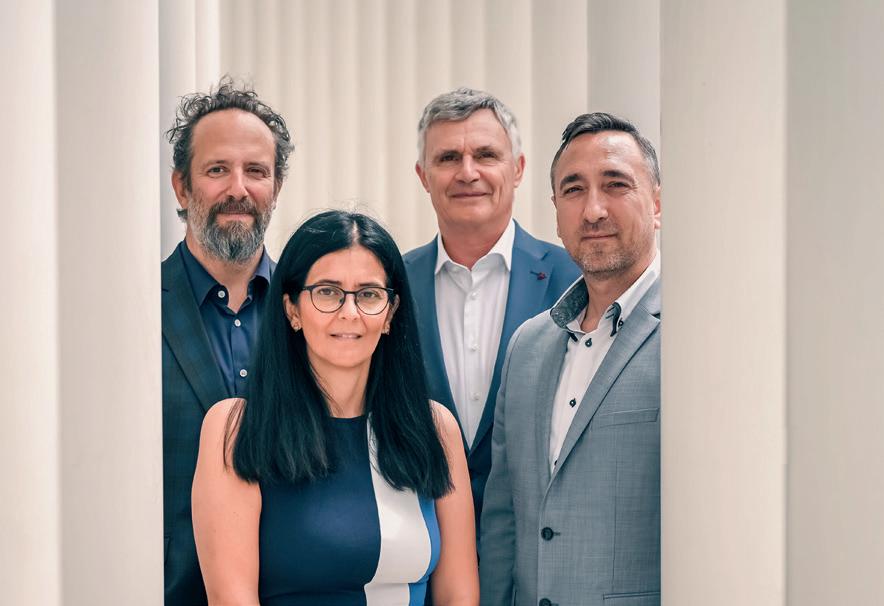



ASSET MANAGEMENT I PRIVATE MARKETS I FAMILY OFFICE www.logiver.com
LOGIVER designs services looking to protect and optimize its clients’ wealth over the long term.
One of the first trips I took in the summer of 2021 (when travelling freely still wasn’t what it used to be) was to the province of Limburg, located in the southernmost tip of the Netherlands. At a certain point, somewhere past the city of Geleen, the scenery suddenly changed from typical Dutch flatlands dotted with grazing cows into a panorama of vast rolling hillsides, castles and quaint villages. When I had first visited the area a decade or so prior, I remember feeling as though I had taken a wrong turn and ended up in France. Especially when I discovered that lush vineyards were also part of the region’s charm. A major bonus for a wine lover like me. But was Dutch wine actually any good? It was. And it keeps getting better every year. During that trip two years ago, I was blown away by an oak-aged red that reminded me of a favourite Bordeaux vintage. Wine of this calibre isn’t only being made in the Netherlands, however. In fact, Belgium and Luxembourg are surprising connoisseurs the world over with wines that are deserving of ample praise. Reason enough not only to devote a regular monthly column to Benelux wines (page 74), but also to shine a spotlight on Benelux’s viticultural landscape in this issue (page 40) and even get acquainted with one of Luxembourg’s finest, Maison Viticole Schmit-Fohl (page 48).
Wine adventures aside, in this issue of Discover Benelux, we’re also heading to Antwerp and highlighting the city’s vibes along with companies and entrepreneurs resolutely proving why it’s definitely Flanders’ ‘capital of cool’ (page 10). If you happen to be a fan of architecture, do check out our ‘Top Belgian Master
Architects’ special (page 20) as well as our feature stories on Antwerp’s Art Nouveau scene (page 68) and the Ghent City Pavilion, located on Emile Braun Square and designed by the architects Robbrecht & Daem/Marie-José Van Hee (page 58).
Enjoy the pages ahead and stay inspired!
Paola Westbeek Editor

Discover Benelux

Issue 80, July 2023
Published 07.2023
ISSN 2054-7218
Published by
Scan Magazine Ltd.
Print
H2 Print
Executive Editor
Thomas Winther
Creative Director
Mads E. Petersen
Editor
Paola Westbeek
Copy-editor
Vera Winther
Graphic Designer

Mercedes Moulia
Contributors
Matt Antoniak
Kristel Balcaen
Monique Gadella
Jennifer Dewar
Debby Grooteman
Scheenagh Harrington
Steve Flinders
Tahney Fosdike
Lidija Liegis
Dana Marin
Johanna Mvumbi
Alison Netsel
Noelia Santana
Paola Westbeek
Cover Photo
Pixabay
Sales & Key Account Managers
Sophie Blecha
Hans Van Muylder
Petra Foster
Publisher:
SCAN CLIENT PUBLISHING
Scan Magazine Ltd. The News Building, 3 London Bridge Street, SE1 9SG, London
Phone: +44 (0)870 933 0423
Fax: +44 (0)870 933 0421
Email: info@discoverbenelux.com www.discoverbenelux.com
© All rights reserved. Material contained in this publication may not be reproduced, in whole or in part, without prior permission of Scan Group – a trading name of Scan Magazine Ltd.
This magazine contains advertorials/promotional articles.
40 Issue 80 | July 2023 | 3 Discover Benelux | Editor’s Note
Contents
JULY Discover Benelux | Contents
2023
COVER FEATURE
40 Wine discoveries in Benelux

Wine lovers these days have more choices than ever. While many still associate excellent wines with countries such as France and Italy, the Benelux countries are also making exceptional wines – in all colours and styles – that are tickling the taste buds of connoisseurs. Get ready to explore and sip your way through Benelux’s fascinating viticultural landscape!
THEMES
10 Made in Antwerp
Situated on the banks of the River Scheldt, the bustling port city of Antwerp’s rich medieval history blends perfectly with its vibrant and modern atmosphere. This urban gem boasts everything from cutting-edge culture and fashion, to cosy shopping streets and bustling terraces steeped in Old World grandeur. The draws of Flanders’ ‘capital of cool’ are endless.
20 Top Belgian master architects, designing the future
Whether its homes, offices, industrial spaces (or those in the hospitality or cultural sector), Belgium counts a host of renowned architects and firms that will turn any idea (no matter how daring) into a reality. In this special, we’ve included a selection of top Belgian master architects who are designing the future. But first, a brief look at some of the country’s architectural highlights.
BUSINESS
28 Column, regulars and more
We take a look at the month ahead in Benelux business, as well as profiling the companies you need to know about. 40 4 | Issue 80 | July 2023
FEATURES
48 It’s a family affair
Wine may not be the first thing that immediately springs to mind when you mention Luxembourg. Yet the country makes great wines and is taking significant strides in the development of organic viticulture. As the land continues to regenerate, it’s only going to get better. Discovering the wines and history of Maison Viticole Schmit-Fohl.
52 Benelux’s best wine bars
Wine connoisseurs, rejoice! Benelux offers a plethora of wine bars and restaurants with stellar wine lists where you can swirl, sniff and sip everything from the finest vintages to hip-and-happening natural wines – all meticulously paired with exquisite gourmet creations and served amidst an inviting atmosphere. Get ready to indulge all your senses and discover new favourites the next time you’re in town!
58 Ghent’s eye-catching City Pavilion
Love it or hate it, the City Pavilion in Ghent, Belgium, is unmissable. Though seemingly out of place at first glance, it often grows on viewers as they start to see its relation to the buildings surrounding it. It is a modern structure in an old city, representing the continued growth and liveliness of Ghent.
64 Unique cinema experience at Royal Theater Tuschinski
A visit to Royal Theater Tuschinski in Amsterdam is guaranteed to be an unforgettable experience. Regarded as one of the most beautiful and luxurious cinemas in Europe, this theatre stands as testament to the power of dreaming big. All it took was a man, a vision and a lot of determination.

68 Antwerp’s Art Nouveau scene
The city famed for its diamonds is also home to the Golden Triangle, an area often regarded as the most important Art Nouveau quarter in Europe. Situated just outside the centre of Antwerp in the Zurenborg district, between Cogels-Osylei, Waterloostraat and Transvaalstraat, this must-visit part of the city offers visitors a chance to gaze up in wonder at some extraordinary architectural masterpieces.
DON’T MISS
6 Desirable Designs | 8 Fashion Picks 34 Out & About | 74 Columns
64 Issue 80 | July 2023 | 5 Discover Benelux | Contents
DESIRABLE DESIGNS
Iconic tableware for your next dinner party
What are you bringing to the table? Adorn your spread with innovative decor, sleek cutlery and alternative crockery. You’ll want to use these pieces again and again – even after your guests have left. No need to wait for a posh dinner party. Dress up your table every day with these joyful yet classy ideas.
A little imagination goes a long way. Iris Lucia’s ‘Between the Lines’ collection presents teapots created from bioresin and 3D-drawn lines. The reimagined object will be a conversation starter for your guests as they notice it among the table’s more pragmatic, daily items. No two are alike. Let this sublime teapot revitalise and redefine your next soirée.

€100
www.irisluciadesign.com
Feature more than silverware in your cutlery collection. Bring gold (and black) into the mix. Savour each bite with this refined stainless steel cutlery set. Including knives, forks, spoons and dessert spoons, the collection will dress your table with a premium and timeless beauty.

€236-78
www.venettodesign.com
TEXT: TAHNEY FOSDIKE | PRESS PHOTOS
2. Teapot
1. Xena Cutlery Set
1.
6 | Issue 80 | July 2023 Discover Benelux | Design | Desirable Designs
2.
Let’s not get sidetracked by trying to be too polished. Dinner parties let us bring more vibrancy into our lives. Delight your guests with these multicoloured tumblers with different designs to match their mood and whatever beverage that’ll quench their thirst. Cheers to you, and you and you!

€95
www.polspotten.com
We don’t believe in cutting corners when it comes to sustainability. This tray aligns with our values as a genuinely sound piece, both in structure and style. You’ll admire the unique characteristics of your handcrafted object, which is built to last with Terrazzo mixed with reclaimed steel. Perfect for serving a variety of dishes, the piece will bring maturity and depth to your table arrangements and every occasion.

Price on demand
www.mahautvanpeel.com
Now that you’ve switched to gold cutlery, you’ll need more of your utensils to match. These salad servers made from brass will age gracefully as the years go by – from shiny and new for you today, to a seasoned
 4. Salad server, gold
3. Tubular Tumblers
4. Salad server, gold
3. Tubular Tumblers
Discover Benelux | Design | Desirable Designs
5. Zarbo Tray
3.
Issue 80 | July 2023 | 7
5.
Embracing the sun
As we welcome summer once again (hopefully with plenty of long days and sultry nights), our minds are set on those functional pieces that can be worn throughout the season –whether we’re staying in the city, hitting the beach or exploring new lands.
TEXT: NOELIA SANTANA | PRESS PHOTOS
An easy-to-wear two-piece
The co-ord set is the epitome of easy summer dressing. The slightly oversized shirt can be worn with jeans, tailored trousers, over a simple dress, a swimsuit, you name it! Pair it with the matching shorts for an effortless but extremely stylish outfit. No need to spend much time thinking about what to wear: this co-ord will be your best friend during the holidays.

Marks & Spencer, pure Irish linen shirt €82, shorts €70
www.marksandspencer.com
The raffia bag

A raffia bag is the perfect accessory for summer. We love the UFO collection by MAM. It’s big enough for all your knickknacks and must-have items during your beach escapade, yet lightweight and made to last. This versatile piece can be worn two ways: with two straps as a chic tote or as an across-the-body bag for the ultimate functionality.
MAM, UFO raffia bag, €260
www.mamoriginals.com
JULY FASHION
PICKS
8 | Issue 80 | July 2023 Discover Benelux | Design | Fashion Picks
A pair of sandals for everything
When choosing footwear for a holiday, we recommend going for a simple pair that you can wear with everything from casual shorts to floaty summer dresses. The ‘Endless Summer’ sandals by Everlane might be just the answer. The style combines the very trendy thong with an adjustable ankle strap that will keep your foot in place while walking down the beach boardwalk. Comfort without compromising on elegance.
Everlane, the Endless Summer sandals, €149 www.everlane.com

The cool shirt
Breathable materials are a must when dressing for summer. Good reason to add this textured floral shirt to your wardrobe. Crafted in 100% cotton, it will not only keep you cool even on the hottest days, but is also super stylish.
Boden, palm leaf sun print, €66 www.boden.com

The seashell earrings

It might be an obvious choice while enjoying a beach holiday, but we love to accessorise with gorgeous elements straight from the sea. This pair of seashell earrings from Mango will add the ultimate summer accent to your simple white t-shirt and jeans combination, but it’s also perfect for elevating a gorgeous knit dress to wear to dinner in the evening.
Mango, mixed bead earrings, €22.99 www.mango.com
Discover Benelux | Design | Fashion Picks
Issue 80 | July 2023 | 9
Made in Antwerp
Situated on the banks of the River Scheldt, the bustling port city of Antwerp’s rich medieval history blends perfectly with its vibrant and modern atmosphere. This urban gem boasts everything from cutting-edge culture and fashion, to cosy shopping streets and bustling terraces steeped in Old World grandeur. The draws of Flanders’‘capital of cool’ are endless. Here are three reasons to plan a visit.

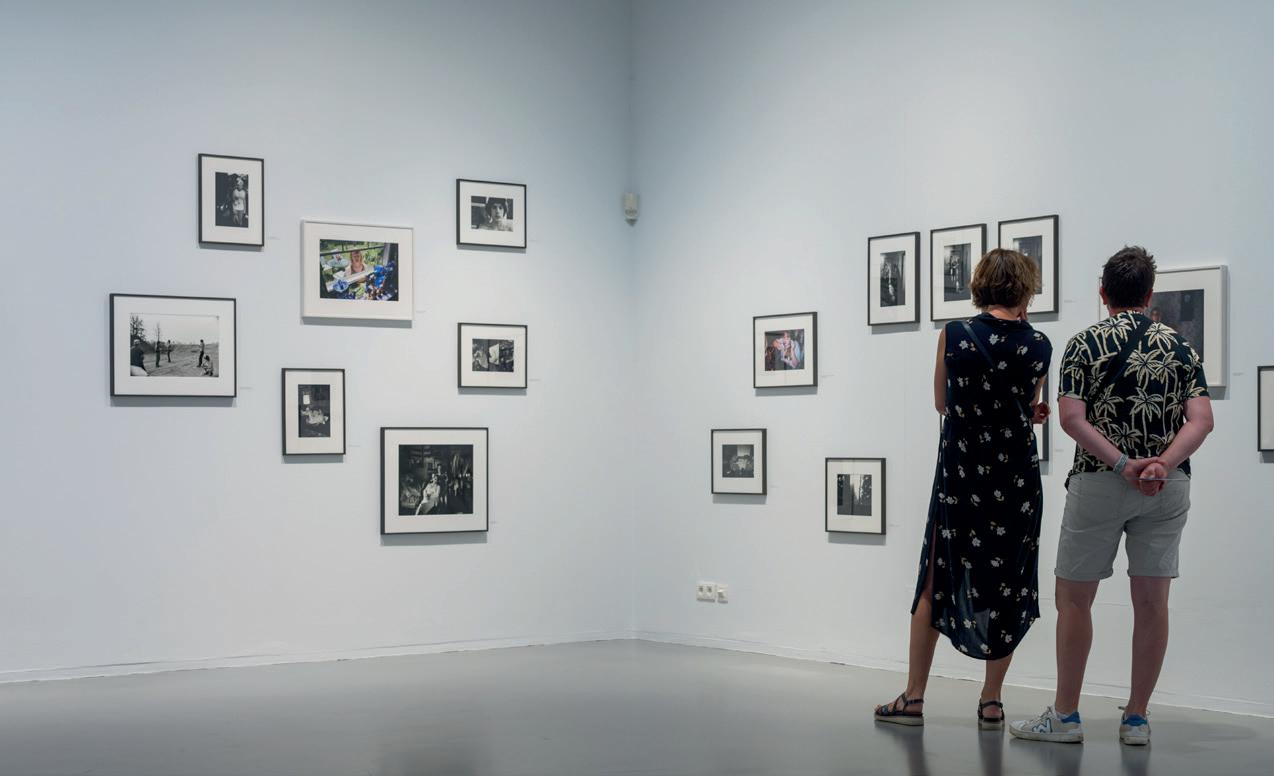 TEXT: PAOLA WESTBEEK
FOMU. Photo: Woodmonkey
TEXT: PAOLA WESTBEEK
FOMU. Photo: Woodmonkey
10 | Issue 80 | July 2023
Port House. Photo: Lebak Photography - Zaha Hadid Architects
Soak up some culture
Antwerp certainly has its share of awe-inspiring museums. Among them is the Museum of Contemporary Art (M HKA), located in the south of the city, a cultural hotspot teeming with galleries and other cultural gems such as the Photo Museum (FOMU) and the Royal Museum of Fine Arts. Antwerp is the world’s diamond capital, so it should come as no surprise that there is a museum dedicated to these precious gemstones. At the DIVA Antwerp Home of Diamonds, visitors can learn about the history of these and other luxury goods while admiring the lavish collection. The MAS (Museum aan de Stroom), located on the old port neighbourhood Het Eilandje, has a collection of over 500,000 pieces divided over nine floors. There’s even a rooftop terrace where you can take in an exceptional bird’s-eye view of the city.
Historic allure
In the 16th century, the expanding city of Antwerp earned its mercantile reputation
and was one of the most important trading ports in Europe. Today, not only does Antwerp continue to grow and thrive (in the last 10 years, its population increased by 50,000), but the cosmopolitan city happens to be home to Europe’s sec-

ond-largest port. Despite the hustle and bustle, Antwerp manages to retain a laidback atmosphere and small-town feel.
If you’re arriving by train, be prepared for a grand entrance at its magnificent cen-

Discover Benelux | Special Theme | Made in Antwerp
View from Het Steen.
Photo: LUCID
Issue 80 | July 2023 | 11
M HKA. Photo: Victoriano Moreno
tral station. Trumping the list of the world’s most beautiful railway stations, this architectural masterpiece was constructed between 1895 and 1905 in an eclectic mix of styles. The iconic station (situated just 30 minutes from Brussels Airport) is not only a convenient way to access the Flemish hub, but is one of the most impressive welcomes a city can offer.
Het Steen, the city’s cradle and oldest monument, also serves as a gateway to Antwerp as well as a cruise terminal and a central point for tourism. The building, which originated as a fortress and was later a prison and a museum, is one of the must-see landmarks on the banks of the River Scheldt. It houses the city’s Visitor Center, The Antwerp Story (an attraction that serves as the ultimate introduction to those new to the city) and a panoramic terrace where you can indulge in a sprawling 360° view over the city.
From here, you’re just a pleasant five-minute stroll from Grote Markt, a historic and animated market square in the old quarter with myriad fine restaurants, bars, terraces and striking buildings that vie for your attention. One of them is

the Town Hall, a UNESCO World Heritage site with a jaw-droppingly beautiful Renaissance-style facade. Other architectural wonders in the city include the richly decorated guild houses and the striking Port House (a former firehouse crowned with a diamond-shaped structure designed by renowned architect Zaha Hadid). Also worth mentioning are
the sumptuous Art Nouveau buildings that will take you back to the glory days of the Belle Époque.
Indulge the senses
Of course, chocolate is one of the city’s gourmet attractions, but there’s also something to be said about indulging in a paper cone filled with thick-cut chips, piping hot and served with a dollop of mayonnaise. If beer is your tipple of choice, pop into a ‘brown café’ or terrace and sip on a local brew such as a ‘Bolleke’ from the De Koninck (one of the many breweries open to the public). For fans of fine dining, it’s good to know that there are a wealth of restaurants to satisfy even the most discerning of palates.
Antwerp has made a name for itself in the fashion scene with designers such as Dries van Noten and the many boutiques that have made the city a shopping mecca where retail therapy takes on a whole new dimension. Strolling along the main shopping street (Meir), you’ll come across international chain stores, but don’t forget to look up and admire the striking Rococo architecture!
After your urban adventure, end the day by hopping on the free ferry to the left bank and feasting your eyes on the city from a distance. It’s easy to see why the city has been captivating visitors for centuries.

Discover Benelux | Special Theme | Made in Antwerp
Het Eilandje and MAS. Photo: Gianni Camilleri
12 | Issue 80 | July 2023
DIVA. Photo: Frederik Beyens
 Stroll through Grote Markt. Photo: LUCID
Stroll through Grote Markt. Photo: LUCID
A hidden pearl with a unique history
TEXT: DEBBY GROOTEMAN | PHOTOS: CITY PALACE ANTWERP

City Palace Antwerp is a unique building adorned with authentic details dating back to its construction in 1865. It stands as a truly distinctive structure among the other buildings. Boasting a city garden with vibrant green surroundings where chirping birds serenade the visitors, this building encapsulates uniqueness in every aspect and offers an exceptional experience.
When owner Christian Melisse first laid eyes on the building, the necessity of extensive restoration to bring it back to its original splendour became evident. Over a span of nearly two years, starting in 2009, a dedicated team of approximately 50 people worked to meticulously restore every square centimetre. Melisse: “Our objective was to transform the building
into a new state, while preserving all its authentic details. The building itself became our guiding compass, directing us on how to proceed. Whenever we needed to add functionality, we carefully considered the perspective of the architect in 1865. We contemplated what advice he would have offered and which materials he would have recommended using.” This

resulted in what is now one of the most beautiful buildings in Antwerp; one which is still in private hands.
During the renovation, Melisse discovered not only elements from the original owner, but also enhancements made by the second owner. “What was really special is the exceptional care and respect exhibited in their handling of the building,” Melisse explains. “Often, you see individuals purposely removing original elements to make way for modern additions such as bathrooms or kitchens. However, in this particular case, elements such as stained glass were added, without destroying the authenticity of the building. This resulted in an upgrade that showcased the remarkable balance between modernisation and historical integrity.”
14 | Issue 80 | July 2023
An array of original elements
Melisse highlights that the fact that numerous original elements were available for the building’s restoration is truly exceptional. “The building holds 80 doors. All of them still have the original hinges and locks, which is unique. During the restoration process, we discovered a multitude of original items throughout the building. We have the previous tenant to thank for that – an old lady who didn’t throw anything away. We were able to effectively repurpose these salvaged components.”
While not all elements are from the 19th century, Melisse acknowledges that certain items needed replacement. “There are things you can’t reuse. We needed to buy new toilets, for example. However, careful consideration was given to ensure that the design and style aligned with the original construction period. We chose English porcelain for the toilets, and we found a company that specialises in incorporating decorative lines beneath the curtains.”

Authenticity bathed in natural sunlight
What truly sets this building apart, according to Melisse, is its authenticity along with the delightful surprise of rays of sunlight filtering through the windows. Melisse: “It’s unique that this building has large, open spaces and generous windows.
The stairs that were used by servants in previous times were replaced by a lift, and the central entrance features a grand staircase with a sizable high window.” Another remarkable feature is the layout of the rooms. “You would expect to find small cramped rooms and corners in this building, but on the contrary, it boasts a logical arrangement with ample spaces,” says Melisse. “All the rooms are connected to the central staircase, which provides a harmonious flow and abundant natural light. Oftentimes, old buildings tend to be dim and dull. This building is the opposite, radiating brightness and charm.”

The building encapsulates an extraordinary history as the first owner used to organise concerts in the large rooms and the garden. Victor Lynen was a prominent figure during the second half of the 19th century. As one of the wealthiest people in Belgium,


he maintained connections with members of the royal family and played a significant role in the development of Antwerp’s harbour. “It is also known that he took great pleasure in hosting concerts for his business associates. Renowned artists such as Franz Liszt and Pjotr Iljitsj Tsjaikovski graced this building with their performances. You can compare this to inviting the Rolling Stones to perform at your house today,” Melisse points out. Lynen also used to surround himself with writers and artists. This resulted in the collaborative involvement of some artists in the building’s decoration. Notably, the handmade embellishments adorning the staircase were crafted by Louis Van Boeckel. Additionally, Jacques De Braekeleer is responsible for the impressive fireplace adorned with sculptures of women.
www.citypalace-antwerp.com

Discover Benelux | Special Theme | Made in Antwerp Issue 80 | July 2023 | 15
Emotion in art photography


a full-time photographer “on a level that borders on art”, producing several books from an ethnic viewpoint, until he wasn’t surprised by this anymore.
Van Gestel is still inspired by African people and landscape, but now focusses on a parallel world that nearly connects to reality. He balances on a tightrope with his surrealistic, multi-layered artworks. These images are printed on a large scale and exhibited not only in his own gallery in Antwerp, but also in New York and Paris. The photos will also be incorporated in his new book, Just Passing By, due to come out in September.
tant, digital cameras give a better result,” says Van Gestel. “Whatever the method, whatever the subject, I am totally focussed on creating a unique work of art.”
Forty years ago, Van Gestel ended up in Lamu, one of those hidden treasures he is reluctant to talk about. “The authenticity of this small island is what draws me in. It’s like a small Zanzibar,” he says. There are no cars on the island, and everything is transported by donkeys or boat. Van Gestel particularly likes that there are no external stimuli. He experiences a creative boost every time he visits.
Thought-provoking, full of drama and emotion – the pictures taken by Eddy van Gestel are one of a kind. Based in Antwerp, but living mostly in Lamu (a small island in Kenya), he takes inspiration from Africa’s people and landscapes. The images are not just portraits or still lifes – they are fine art.




As a young man, Van Gestel was fascinated by both art and mystical Africa. He travelled throughout the continent and ended up as a wildlife photographer. Besides his passion for photography, he also loves books and became a publisher. But, in 2010, he decided to become
The photography is done with either an old analogue or a high-end digital camera, depending on the subject matter. “If the dynamic reach – from dark to light – is impor-
If you are interested in the relativity of life and want to purchase his artistic photography, visit the website. You’ll be amazed.
www.eddyvangestel.com
TEXT: MONIQUE GADELLA | PHOTOS: EDDY VAN GESTEL
Discover Benelux | Special Theme | Made in Antwerp 16 | Issue 80 | July 2023
Fall deeper in love with Belgian chocolate
TEXT: MONIQUE GADELLA | PHOTOS: CHOCOLATE NATION
At the Chocolate Nation museum in Antwerp, visitors can experience a proper Willy Wonka moment. “It is as if you have won the golden ticket!” a delighted visitor once commented. This is no ordinary museum. It’s an experience.



As if by magic, the doors open and your journey through the world of Belgian chocolate begins. Discover the origins, transport, traditions, history, brands, products and innovation of chocolate in 14 rooms. A large, fantastical machine explains the complicated process of making chocolate from cacao beans. It’s a truly magical masterpiece. It all culminates when you descend via a golden staircase to a room where you can taste ten different kinds of chocolate.
Belgium is synonymous with chocolate, and Antwerp is the largest chocolate port in the world. This prompted Mickelle Haest and Jeroen Jespers (managing partners and chocolate lovers) to open the city’s Chocolate Nation Museum. Haest realised that no one was telling the story about the product that is so
uniquely associated with Belgium and created the museum in 2019.
Cacao beans grow in countries located at 20 degrees latitude on either side of the Equator, and at the museum, you can taste the difference between chocolate
from Africa and South America. Visitors get a spoon – made from recycled plastic – to taste the different flavours of liquid chocolate. The liquid form makes you taste the chocolate better. Wine has 200 different tasting notes; chocolate has 400.
The museum attracts all kinds of visitors. Haest: “Men often tell us that they were dragged here by their wives, but were glad they came. It is such a unique museum.” Chocolate is kosher and halal, so it is suitable for everyone and people of all ages. It’s no wonder that people from around the world have found their way to the largest Belgian chocolate museum in the world.
“Chocolate also leads to romance,” says Haest. “Many proposals have taken place here.” The museum can construct a chocolate ball around the ring, which the bride-to-be knocks with a special hammer. If you love chocolate (and who doesn’t?) the Chocolate Nation Museum is a tasty treat and definitely worth a visit.
www.chocolatenation.be
Discover Benelux | Special Theme | Made in Antwerp
Fantasy chocolate-making machine where the magic happens.
The moment you descend the golden staircase, you arrive in chocolate heaven.
Issue 80 | July 2023 | 17
Taste pink chocolate and nine other flavours.
Classic meets contemporary
TEXT: JOHANNA MVUMBI | PHOTOS: SALIMA THAKKER
Salima Thakker is a renowned Belgian jewellery designer, passionate goldsmith and creative mastermind behind extraordinary and unparalleled jewellery collections. With a remarkable career spanning 25 years, Salima Thakker’s ingenuity shines through her exceptional craftsmanship. Her daring creations showcase her vivid and inventive essence laced with a touch of vibrancy, making her work exquisite and exclusive.
At the heart of Salima Thakker’s creations lies the connection between the wearer and the jewellery, making for a truly personalised experience. Her collections encompass fixed designs and bespoke creations, ensuring a wide range of options for her clientele. Thakker’s designs lure individuals from all over the world through curiosity and attraction.
The designer’s signature style combines traditional elements with contemporary aesthetics. Thakker’s sensitivity to materials, especially gold, has influenced her designs. Through carefully selected material combinations, she creates harmonious pieces that resonate with her discerning
clientele. While remaining classic, the pieces feature a distinctive element that colours just outside the lines and goes beyond the conventional boundaries of design, setting them apart from commercial jewellery.



The Modular Collection, Thakker’s artistic signature collection, was designed to adapt to the wearer’s movements while retaining its monumental yet slick character. Thakker: “After 20 years, this is a collection for which I could create designs endlessly.” On the other hand, The Sweets and Treats Collection showcases eclectic creations that exist purely for the joy of creativity. “This collection is an amalgamation of all my random little creative triggers,” she says.
Thakker goes beyond creating jewellery. She creates a captivating story involving many layers, honouring the clients, the materials and their characteristics, and immersing her clients into the creative process. She has cultivated a loyal customer base that values the exclusivity and the thoughtfulness behind her pieces.
With a strong emphasis on personalisation, Thakker also offers a mix-and-match
approach, allowing clients to create unique combinations that reflect their individuality while remaining accessible. The meticulous sourcing of materials ensures the perfect match for each individual.
Aside from her fixed and bespoke creations, Thakker offers the service of transforming old jewellery into personalised pieces, without compromising their integrity or sentimental value. Thakker: “I design jewellery that will stand the test of time and is meant to be cherished and passed down through generations.” With an unwavering commitment to sustainability, Salima Thakker’s collections embody durability as well as timeless elegance.
Salima Thakker’s stores in Antwerp and Knokke are must-visit destinations for those seeking jewellery with a distinct story and personal touch. Make sure to attend the extraordinary experience at Salima Thakker’s stores. From 21 July to 27 August, the Knokke location presents ‘House of Collabs’, celebrating 10 years since its grand opening.
www.salimathakker.com Discover Benelux | Special Theme | Made in Antwerp 18 | Issue 80 | July 2023
The art of creative cocktails
TEXT: JOHANNA MVUMBI | PHOTOS: WWW.NICCOLA.BE
Since its opening in September 2022, Marigold has been delighting patrons with its unique blend of exquisite cocktails and delectable comfort food. As a true testament to the power of friendship and pursuing passions, Marigold is the project of two best friends, Nicolas Oorts and David Vanheesbeke, who dreamed of opening a cocktail bar where they could unleash their creativity and share their creations.
Located in the picturesque Vrijdagmarkt in Antwerp, Marigold’s minimalistic elegant interior sets the stage for an extraordinary experience. The bespoke cocktail bar offers a selection of high-end cocktails that are the result of extensive research and experimentation. The complex recipes and carefully crafted ingredients (often made in food labs) ensure that each sip is a work of art.
Marigold goes beyond the traditional concept of a cocktail bar and serves comfort food inspired by Italian and American cuisine. Guests can indulge in dishes like ‘aranchino’, perfectly comple-
menting the casual and welcoming atmosphere as well as making it more than just a place for drinks.



At the heart of Marigold’s cocktail menu is their collection of signature creations. The ‘Magdarita’, for instance, is a Flemish twist on the classic margarita. Made with Belgian vodka, strawberry and mandarin Napoleon, it offers a unique blend of flavours that tantalises the taste buds. The signature cocktails are the result of countless experiments, cocktail fairs and a relentless pursuit of perfection. It was through this process that Marigold created their renowned ‘Nutella Old Fashioned’, featuring hazelnut syrup and chocolate bitters infused with the rich flavours of hazelnut.
Marigold takes great pride in taste, placing it above elaborate decorations. “We believe the cocktails should speak for themselves,” says Oorts. “Any garnish has to have added value in terms of enhancing the taste.”
Marigold is an accessible and inclusive destination for all drinks enthusiasts,
whether guests crave original cocktails, a glass of wine or a refreshing beer.
This July, Marigold will release their new menu, featuring a range of tantalising signature cocktails. Among the highlights is the ‘Gypsywater’, inspired by the enchanting scents of Swedish perfume. With notes of wood, warmth, citrus and vanilla, this captivating elixir promises to become a rare gem in Marigold’s cocktail repertoire.
Unlike other bars, Marigold shies away from advertising their menu. They want visitors to come solely for the adventure and discovery, guided by the expertise and passion of their talented team. The element of curiosity is carefully cultivated, allowing guests to embark on a sensory journey like no other. If you’re seeking an extraordinary cocktail experience that combines creativity, taste perfection and a touch of international flair, Marigold invites you to embark on an unforgettable journey.
Discover Benelux | Special Theme | Made in Antwerp Issue 80 | July 2023 | 19
www.marigold.bar
Top Belgian master architects, designing the future

Whether its homes, offices, industrial spaces (or those in the hospitality or cultural sector), Belgium counts a host of renowned architects and firms that will turn any idea (no matter how daring) into a reality. In the following pages, we’ve included a selection of top Belgian master architects who are designing the future. But first, a brief look at some of the country’s architectural highlights.
 TEXT: PAOLA WESTBEEK
Bruges’ belfort. Photo: Visit Bruges © Jan D’Hondt
TEXT: PAOLA WESTBEEK
Bruges’ belfort. Photo: Visit Bruges © Jan D’Hondt
20 | Issue 80 | July 2023
Atomium. Photo: Normann Szkop © 2020 – www.atomium.be – SOFAM Belgium.
With its rich history mirrored in a broad spectrum of eye-catching building styles, Belgium has plenty to offer architecture enthusiasts. Everything from opulent Gothic cathedrals to modernist designs –many of them declared UNESCO World Heritage Sites – can be spotted in major cities such as Brussels, Ghent, Bruges and Antwerp. Well-preserved examples of medieval architecture include the Belfort, towering at 83 metres in the historic centre of Bruges and dating to the 13th century. It is one of the city’s three iconic towers, together with the towers of the Church of Our Lady and Saint Saviour’s Cathedral. In Ghent, Saint Bavo’s Cathedral is one of the city’s medieval gems. Home to an incredible collection of artworks such as the Van Eyck Brothers’ Ghent Altarpiece (covered in our June issue), the impressive structure was built

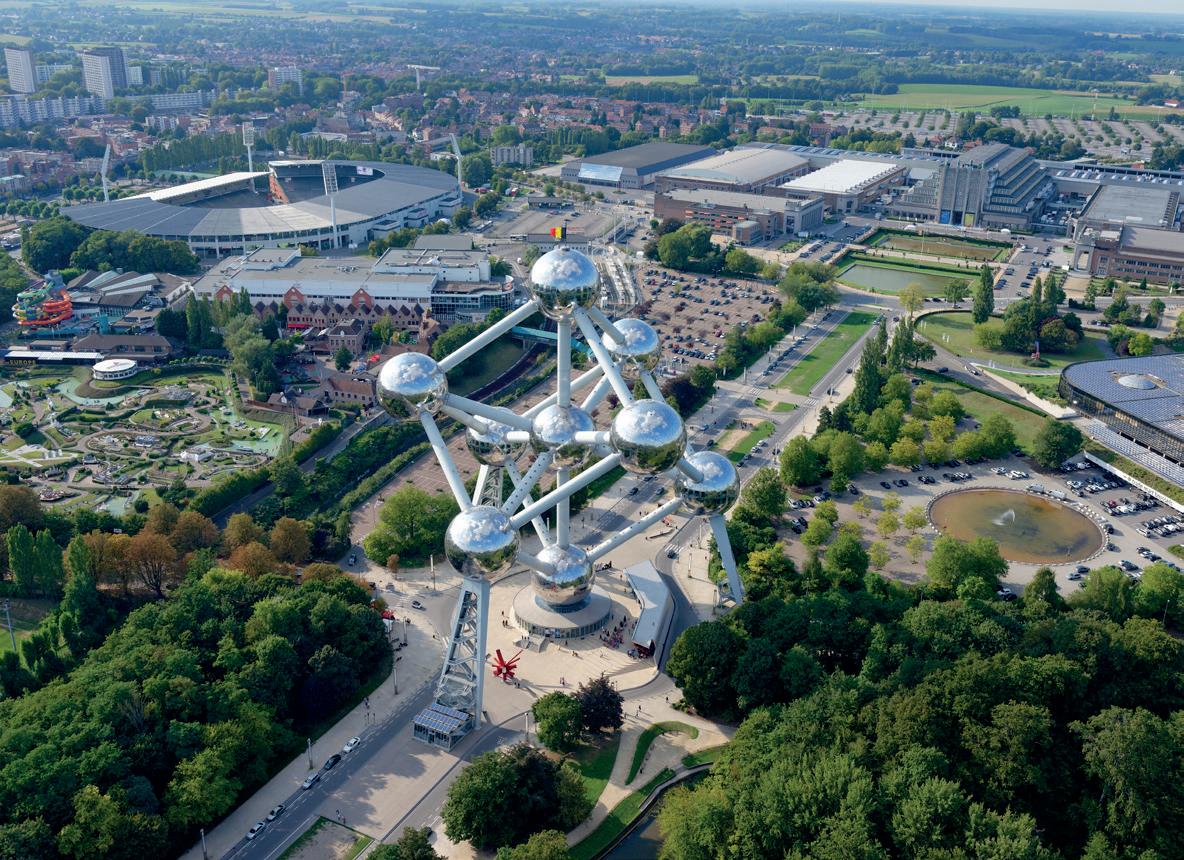
Discover Benelux | Special Theme | Top Belgian Master Architects, Designing the Future
The Cathedral of Our Lady, viewed from the Groenplaats (Green Square). Photo: Rolf Kranz Issue 80 | July 2023 | 21
Atomium in Brussels. Photo: © Visit Brussels, Global
between the 13th and 16th centuries and keeps guard over the heart of town at 89 metres. Another fine example of medieval grandeur is Antwerp’s Cathedral of Our Lady, one of Europe’s most renowned Gothic edifices. With its 123-metre spire, it boasts the country’s tallest church tower. Consecrated in 1521, it is not only a sight to behold from the outside, but also happens to be home to exquisite Baroque masterpieces by Peter Paul Rubens, such as The Descent from the Cross, rendered between 1612 and 1614. In Brussels, the Grand-Place’s Gothic Town Hall, built between 1401 and 1455, has a sumptuously ornamented facade and a tower that dominates the city’s skyline at 96 metres. Among the country’s stunning Baroque architecture, characterised by dramatic forms and elaborate ornamentation, is Antwerp’s Saint Charles Borromeo Church. Erected between 1615 and

1621, it was once the city’s Jesuit church and housed 39 ceiling paintings by Rubens. Unfortunately, these lavish masterpieces were lost in a fire that ravaged the church in 1718.

Toward the end of the 19th century, the city played a pivotal role in the booming Art Nouveau movement, characterised by organic forms, curved lines and intricate detailing. There are many handsome examples of this architectural style in the Zurenborg district. To read more about Antwerp’s Art Nouveau scene, turn to page 68.
Finally, when it comes to contemporary architecture, no better example than the iconic Atomium in Brussels, designed for the 1958 World Expo and one of the capital’s most famed and photographed tourist attractions.
Discover Benelux | Special Theme | Top Belgian Master Architects, Designing the Future
Antwerp’s Saint Charles Borromeo Church. Photo: Visit Antwerp, Siemon Vanderhulst
Interior of Cathedral of Our Lady in Antwerp.
22 | Issue 80 | July 2023
Photo: Visit Antwerp, sigridspinnox
 The Town Hall on Grand-Place in Brussels. Photo: Visit Brussels, Jean-Paul Remy
The Town Hall on Grand-Place in Brussels. Photo: Visit Brussels, Jean-Paul Remy
Designing industrial buildings with the perfect ambiance
From the initial analysis to the grand master plan for the new design of an industrial building, Bofa Architects possesses a profound passion for assisting small and medium-sized businesses. Their primary focus is on bringing a project to life by creating a building that is enjoyable to work in and look at.
The overall appearance of a building should be something to be proud of and something that offers a boost for everyone involved. The face of Bofa Architects is architect Steven Winderickx. After working on different projects, including renovations and offices during the initial years, Winderickx made a deliberate choice to specialise in designing industrial buildings for small and medium-sized enterprises (SMEs). This focused approach has been in place for several years now. Winderickx explains how he always had a love and passion for industrial spaces: “In the early nineties, I had the personal experience of purchasing an old industrial building to renovate in Brussels. And alongside my affinity for these buildings, I also have a profound appreciation for the entrepreneurial aspect of business. I hold a great admiration and respect for business people and their way of managing companies.” Winderickx describes them as interesting people with a clear vision for their company. According to
Winderickx, they only need an architect to bring their project to life and translate their vision into a compelling and fitting building that really makes a statement.
Custom-made industrial building with fitting look and feel
One of the projects Winderickx is extremely proud of is the remarkable transformation of an old industrial building for Morgan Belgium. Winderickx explains that Morgan is a distinguished British brand that manufactures classic cars. “They sought to relocate their dealership to a fantastic old industrial property. The construction needed extensive restoration, but to keep the look and feel of the building, we really made a dedicated effort to save some of its old elements and incorporate them in the new design.” While Winderickx immersed himself in the design for the renovation of the building in Belgium, coincidentally, the headquarters in London also underwent an upgrade. “Initially, we didn’t have any knowledge about

 TEXT: DEBBY GROOTEMAN | PHOTOS: JO PAUWELS
TEXT: DEBBY GROOTEMAN | PHOTOS: JO PAUWELS
Bofa (Morgan Belgium). 24 | Issue 80 | July 2023
Bofa (Morgan Belgium).
the direction the architects in England were taking with their design. Upon completion of both projects, it was astonishing to discover we created exactly the same look and feel. However, from my perspective, the building in Belgium exudes a heightened sense of elegance. I find it truly fascinating that, independently of each other, we interpreted and embodied the story the same way.”
Winderickx has a variety of people in mind when designing a building. “A building needs to be functional and have a beautiful appearance. The aesthetics of the building shouldn’t be forgotten. There is nothing more pleasant than looking at a captivating building that exudes a ‘wow’ factor. This not only applies to the people who work in the building, but also to visitors and the public from the surrounding neighbourhood.”
Harmonizing a building with the urban landscape



Designing industrial buildings is a complex undertaking that involves careful consideration of different factors. According to Winderickx, it poses more challenges than designing simpler office spaces, for example. “Industrial complexes contain expansive surfaces, which inherently need larger budgets. From my standpoint, it’s crucial to approach these projects with an open mindset to get the most out of them. We want to use the available tools and resources to create the most impressive
appearance possible within the designated budget. Additionally, it’s crucial that the look and feel of the building align harmoniously with its intended functionality.” For Winderickx, the urbanistic landscape also plays an indispensable role. A standard warehouse can be considered as a missed opportunity to optimise space. He adds: “I am really aware of the surroundings and strive to make them an integral part and essential component of the total story we want to tell.”
A topic that has become increasingly relevant in recent years is sustainability. “Technology has undergone an evolution, and we now possess advanced possibil-
ities when designing a building. Our aim is to create a building that is completely self-sustainable, with optimised isolation, heat pumps and solar panels, among other features,” Winderickx explains. A great example is the more classic building of PowerSolutions. The building is designed to be timeless, incorporating cutting-edge installation techniques. However, this approach comes at a cost. Winderickx adds: “Yet entrepreneurs know that the years fly by. By investing now, in 10 years, they will still have a building that sustains the test of time and is viable for many more years to come.”
www.bofa-architects.be
Discover Benelux | Special Theme | Top Belgian Master Architects, Designing the Future
PowerSolutions.
Bofa (Morgan Belgium).
Issue 80 | July 2023 | 25
PowerSolutions.
Inspirational design on different scales
TEXT: MONIQUE GADELLA
With a great eye for detail, Veerle van de Walle and Francesca Bonne run Altu, a multidisciplinary architecture studio. As trained architects, they work on a variety of projects (residential, cultural and in hospitality), sometimes renovating or extending a building and sometimes designing it from scratch. Unique in that every building comes with a custom interior. Altu’s talented team even designs objects like lampshades
Van de Walle and Bonne take inspiration from their extensive travels from Italy to South America. They like to visit projects by their design heroes, such as Lina Bo Bardi, who has designed many people-friendly buildings in Brazil. During the design process, Altu looks to the past and reinterprets architecture in a contemporary and sustainable way. An example is when they used thatch as a facade material in a project, not only for
its aesthetics but also to reduce environmental impact. For your next project, consider Altu and you’ll be sure to have a balanced design that is innovative yet steeped in tradition.




www.altu.space

Discover Benelux | Special Theme | Top Belgian Master Architects, Designing the Future
Art & design production facilities, Rotterdam (in collaboration with Cloud). Photo: Cloud
Café ‘t Kanon in Ghent, Belgium.
Photo: Sanne van der Ven & Eefje de Coninck
Altu pendant light, hand-cast resin.
Photo: Mathijs Labadie
Outdoor space of house in Kapellen.
Photo: Depasquale+Maffini.
House in Kapellen, Belgium.
26 | Issue 80 | July 2023
Photo: Depasquale+Maffini
A MULTI-CERTIFIED SMART CAMPUS IN A SMART CITY
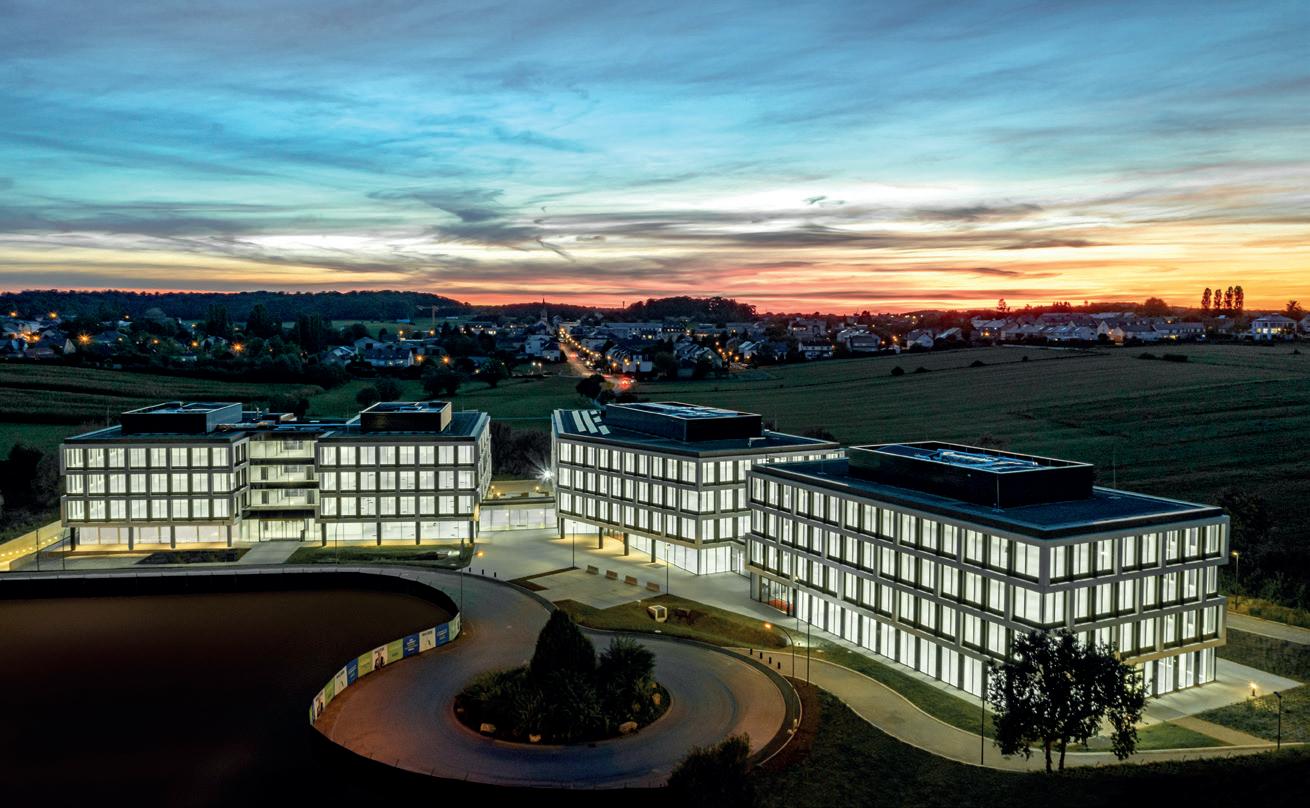
AT THE GATES OF LUXEMBOURG
Buzz is a « smart campus » with ecological intelligence catering to the strictest energy efficiency programs and savings.




Hyper flexible, evolutionary and scalable. The 412 to 12,933 sqm spaces easily adapt to any type of function: open spaces, meeting rooms or individual offices.

The abundance of natural light, thanks to floor to ceiling window bays, natural materials, terraces and walkways, bring a sense of well-being and a convivial atmosphere that stimulates exchange.
www.buzz.lu
www.linkedin.com/company/ buzzluxembourg
Compliant with the highest environmental standards


Benelux Business
Make the journey part of the holiday
Flights in and out of Malta, where I live, have now risen back nearly to pre-Covid levels. Tourists don’t seem to feel much concern for the millions of people not far south of here whose lives are being drastically affected by climate change caused in no small part by air travel.
I was the same. But after two decades of work-related international travel, I now feel increasingly like a climate criminal, which is why I decided to return overland to Malta from a recent seminar in York, England. Here’s a quick balance sheet of the outward and inward journeys:
• Cost. Malta to York by plane and train: €285. York to Malta by six trains and a ferry: €535. The inward journey also involved more spending on food, though not accommodation – family and friends put me up in London, Paris and Turin.
• Time. One day outward, five days back. It could be done faster, but peak fares, especially on Eurostar, would have pushed up the cost even more. Planning and bookings for the homeward leg took much longer.
• Carbon. It’s hard to get accurate figures for the two journeys, but different websites tell me a 2,350-kilometre flight generates between 365kg of CO2 and non-CO2 emissions per passenger and almost double that. Even the lower figure is seven times more than for the trains and ferry. I learnt that slow trains with old rolling stock are much less efficient than high-speed trains. Eurostar’s emissions are just six grams per passenger kilometre compared with 156 grams for a short-haul flight.
• Intangibles. Lunch in the sunshine in Syracuse beats any airport meal anywhere. Going through the Alps one day, and the orange, lemon and olive groves of southwest Sicily the next, I rediscovered the pleasures of slow travel. I read four books. The world rolled by the carriage window. I slept a lot.
We need a personal and political reappraisal of the way we travel. Plane tickets should come with a global health warning. Frequent flyers should be penalised. Governments should create price incentives for train travel over flying. More em-


ployers could give extra ‘journey days’ of holiday to staff who travel flight-free.

Travelling more slowly gives us more time to stand (or sit) and stare. At the same time, we can show some practical support for the peoples of the south who are already suffering terribly because of our insatiable urge to hurry.
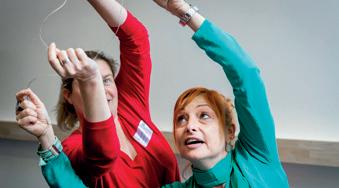
BUSINESS COLUMN | BUSINESS CALENDAR | BUSINESS PROFILES
Steve Flinders is a freelance trainer, writer and coach, based in Malta, who helps people develop their communication and leadership skills for working internationally: steveflind@aol.com
TEXT & PHOTO: STEVE FLINDERS
29 30 32 28 | Issue 80 | July 2023
Business Calendar
AIPC Annual Conference 2023
16-19 July
Luxembourg City, Luxembourg
The annual conference of AIPC, the Global Association of Convention Centres, takes place at the European Conference Center Luxembourg (ECCL). Embracing the theme ‘Let’s Innovate Together’ and featuring a closing keynote session by Professor Sue Black (an inspiring figure in the tech world), this promises to be an interesting event. Participants will have many networking opportunities, from the welcome cocktails to jazz nights and a gala dinner.
www.aipc.org/annual-conference
AAIC – Alzheimer’s Association
International Conference 2023

The European Space Forum 2023
5-6 July
Brussels, Belgium
Two days of debates, under the theme ‘Strength, Security, Resilience – Protecting Europe’s Interests in and Through Space’, bring together key stakeholders and thought leaders from the space sector in Brussels. Lively discussions will cover topics such as the EU space strategy for security and defence, space funding and investment, and more.
https://euspaceforum.com
iGB Live!
11-14 July
Amsterdam, the Netherlands
Over 5,000 iGaming and affiliate leaders gather at the iGB Live! event at Amsterdam RAI. It’s the perfect opportunity to learn strategies for venturing into fresh markets, minimising ad-spend, and surpassing rival companies. Expert speakers, interactive workshops and networking sessions will complete the experience. www.igblive.com
EuropArtFair
14-16 July
Amsterdam, the Netherlands
Presenting European artists with a platform to display their creations and engage directly with art enthusiasts, the fourth edition of EuropArtFair will unfold at the Westergas in Amsterdam. Visitors will have the chance to meet the artists and purchase directly from them, without a third-party commission.

www.europartfair.com
16-20 July
Amsterdam, the Netherlands
Top dementia researchers, clinicians, scientists and the care research community from around the world gather at the largest and most influential international conference on dementia science. This is an opportunity to share innovative ideas, new theories and to advance the work being done in this field.
https://aaic.alz.org
Discover Benelux | Business | Calendar
TEXT: DANA MARIN
AIPC Annual Conference.
Issue 80 | July 2023 | 29
Europ Art Fair. Photo: Almicheal Fraay
The business of diversity, equity and inclusion
There are lots of quotes for students about being a successful entrepreneur, but the Vlerick Business School in Belgium turns those inspiring words into a reality. Every year, Vlerick holds an Expat Event, inviting an international audience to discuss a central theme. This year, it’s the importance of diversity, equity and inclusion, and the keynote speaker is Professor Andreea Gorbatai.
Formerly Assistant Professor of Management at UC Berkeley, Gorbatai became a Professor of Entrepreneurship two years ago, after she moved to Vlerick, which she describes as “an amazing place”.
She is thrilled to be giving this year’s keynote, saying of the event: “I’m very honoured. I really like Vlerick because it’s a business school that is located in the heart
of Europe. We have a Brussels campus and big international ambitions, and I’m very excited to be part of that mission.”
Gorbatai’s focus is diversity, equity and inclusion, which have recently become hot-button issues, especially in the business world. “The past few years have been
very traumatising with lots of global challenges such as Covid, natural and extreme weather disasters and wars,” she says.
Yet while preparing a DEI workshop for executives, she realised the concept of privilege is very hard for many of us to process. “Because when you hear that you have privilege in some way, you hear that you don’t deserve what you’ve achieved,” she explains.
“You work hard, you are competent at what you do, but there are some things that were in your favour or you were not penalised for looking ‘right’ for your position – for example, in terms of gender or skin colour.”
Expanding the talent pool
“The way we think of DEI at Vlerick is essentially starting from the company’s

 TEXT: SCHEENAGH HARRINGTON | PHOTOS: ERIK VAN DER BURGT
TEXT: SCHEENAGH HARRINGTON | PHOTOS: ERIK VAN DER BURGT
30 | Issue 80 | July 2023
mission, from the strategy. Who do you want to be and what impact do you want to make in the world? Based on that, we ask: what dimensions of diversity are relevant to you?”
Gorbatai adds that businesses who hire a diverse range of people automatically increase their talent pool. “If you never have international applicants or women applicants, you’re missing around 60% to 70% of the workforce in a place like Brussels,” she says.

“When you have teams that are homogeneous, it feels very easy and very fun to work together, but there are a lot of blind spots. Yet when you put people together who are different, you do get more and better ideas, more innovation and more ethical considerations. But you only get these benefits from diversity if you have inclusion. If your talented and diverse
employees do not feel respected or safe, speak up!
“I’m trained as a sociologist, so for me, first and foremost, this is not even about access to talent, but about fairness,” she points out. “There are people who have ideas, or who have leadership abilities, or who have a lot of wonderful qualities in our society that are being overlooked because they don’t look the part.
“There’s a path to success because you went to the right school and look like you would be a successful leader or successful entrepreneur, yet the reality is that there are more competent people out there.”
Everyone is human
As a former resident of Silicon Valley, Gorbatai is sceptical about the rise of AI and its potential impact on DEI. “There’s been this big push to have AI ethics teams,
algorithm auditing, transparency and accountability. But often those in charge get carried away by making the algorithm faster, better, getting more clicks, or an increase in engagement or revenue. It’s easy to forget it’s about humans, that the data points represent people,” she says.
This brings her to equity, which has evolved from the broader adoption of diversity and inclusion. Hiring women and minorities is pointless if the organisation is designed with the majority in mind, Gorbatai explains. “A focus on equity is important to remove unfair obstacles from the way that your diverse, talented and qualified employees are treated by the business.

“If you have a party and invite people who are different from each other, everyone needs to feel accepted on the dance floor, too – that’s inclusion. But also, the music that you play has to reflect everyone’s interest. So if you only play heavy metal or electronic music, some people will feel left out. You have to have different ways for people to succeed and show off their talents and skills.
“The point of my keynote is that it’s easy to have general labels when we don’t have direct contact with others. It’s important to have interactions, be open-minded and interact with people who are different from you – and to treat them with fairness and respect. I think it’s imperative for humans to figure this out.”
www.vlerick.com/expat-event

Discover Benelux | New Campus in Brussels | Vlerick Business School
Issue 80 | July 2023 | 31


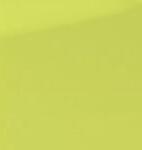





















JOIN US TO DISCOVER WHY DIVERSITY MATTERS FOR OUR FUTURE
EXPAT EVENT 2023 JOIN THE VLERICK EXPAT EVENT 14 SEPTEMBER 2023, BRUSSELS CAMPUS www.vlerick.com/expat-event
Keynote by Professor Andreea Gorbatai
Taking a personal approach
TEXT : JENNIFER DEWAR | PHOTOS: LOGIVER
When it comes to investing your money, making sure you have the right advice is crucial. At a time when stock markets around the world are experiencing volatility, it’s even more important than ever to receive the best investment advice and protect your wealth for generations to come. Logiver can help.
Based in Luxembourg, Logiver is a 20-year-old private wealth management company which has gained a reputation for putting clients at the centre of their business. It provides a tailored service with an emphasis on transparency and clarity for its clients in Luxembourg and across the EU. Supervised by the CSSF (Commission de Surveillance du Secteur Financier) it holds a number of licenses enabling them to, among other things, advise on client investable assets as well as manage them; trade on financial instruments and act as a family office. Logiver essentially designs services looking to protect and optimise its clients’ wealth over the long term.

This past January, Logiver welcomed in a new management team, with Antoine Pasquet at the helm as CEO. Pasquet has two decades of experience in banking, with particular expertise as a controller and auditor. It’s this expertise which is apparent in Logiver’s values – it’s desire to provide a carefully managed, professional service.
Commenting on the firm’s approach, Pasquet says: “It’s quite typical for fund managers to move money around on the stock market, which can mean volatility and higher fees for their clients. Logiver looks for long-term investments – including in private markets – which will yield good returns for our clients, with less risk involved, meaning longer-term security.”
As of 1 July 2023, Logiver has launched its enhanced Family Office services to provide succession planning for its clients. Pasquet: “It can be a tricky and complicated business sorting out family wealth. Our team of advisors can help navigate

the various regulations and laws to find a tax-efficient solution for our clients.”
The team at Logiver is dedicated to finding client-based solutions for wealth management, with an emphasis on keeping fees to a minimum. It is committed to offering a professional bespoke service centered on trust and transparency, careful risk management, a strong network of banking partners and index management using strong market intelligence.
www.logiver.com
Discover Benelux | Best Financial Companies | Logiver
Antoine Pasquet.
Issue 80 | July 2023 | 33
Logiver’s team, from left to right: Mathieu Villaume, Géraldine Varela, René Beltjens and Antoine Pasquet.
Out & About
As July envelops us in its warmth, cities come alive with vibrant events and an abundance of possibilities for fun-filled days and exciting nights. From dance festivals to jazz nights and weekend markets, get ready to immerse yourself in the lively summer atmosphere and create unforgettable memories throughout the month.

34 | Issue 80 | July 2023
TEXT: DANA MARIN Man Ray Exhibition. Photo: Man Ray, Courtesy Fondazione Marconi, Milan
Ghent Festivities
14-23
July, Ghent, Belgium

For ten days in July, the city of Ghent transforms into a buzzing hub during the annual Ghent Festivities, recognised as Flemish intangible heritage and attended by thousands of people every year. The event boasts an incredible array of attractions, including music, various performances, theatre, activities for children and fairs. This is also the only time of the year when you can climb the tower of Saint Bavo’s Cathedral for a spectacular view of the city.
www.visit.gent.be
Hermitage Celebrates Summer

Until 3 September, Amsterdam, the Netherlands
Celebrate the season at the Hermitage Museum by choosing from the multitude of events organised for the duration of the summer month. Expect activities to celebrate the Keti Koti and Pride festivals, outdoor movie screenings, jazz nights, a Sunday market and much more! www.hermitage.nl
Discover Benelux | Culture | Lifestyle Calendar
Ghent Festivities. Photo: VisitGhent
Hermitage Celebrates Summer.
Issue 80 | July 2023 | 35
Photo: Sam Eye Am Photography
Deventer Op Stelten
7-9 July, Deventer, the Netherlands
For the fans of outdoor theatre, Deventer Op Stelten (‘Deventer on Stilts’) is a must-see this summer. The international theatre festival transforms the historical city centre into a giant stage. It’s a celebration of art and culture,

with shows taking places on monumental squares, parks and on the streets, but also in small, enclosed locations. The term “on stilts” is a figurative way of describing the high-quality, top performances happening there for over 20 years.
www.deventeropstelten.nl
Man Ray and Fashion
Until 13 August, Antwerpen, Belgium
This exhibition, organised by MoMu – Fashion Museum Antwerp explores the work of the famous artist Man Ray from the perspective of fashion. Next to the unique photography of Man Ray, there will be creations of contemporary fashion designers and photographers inspired by his work. Visitors have the chance to see work by Chanel, Maison Lanvin, Madeleine Vionnet, Norine, Yves Saint Laurent, Martin Margiela, Olivier Theyskens and Dries Van Noten. https:// mo-mu-news.prezly.com/ man-ray-and-fashion
Gala des Étoiles
8-9 July, Luxembourg City, Luxembourg
The anniversary edition of the Gala des Étoiles, organised by DanceXperience asbl, takes centre stage at the Grand Théâtre. This remarkable dance extravaganza marks a bittersweet moment as it is likely to be the final edition. Global star Lucia Lacarra and her partner Matthew Golding join other acclaimed dancers from classical and modern dance;
 Deventer Op Stelten.
Photo: Events dEVENTer
Gala des Étoiles, Evelina Godunova Young Gyu Choi.
Deventer Op Stelten.
Photo: Events dEVENTer
Gala des Étoiles, Evelina Godunova Young Gyu Choi.
36 | Issue 80 | July 2023
Photo: Christian Kieffer
among them Svetlana Zakharova, Larissa Lezhnina, Marianela Nunez, Maria Eichwald, Ketevan Papava, Alessandro Staiano, Alexey Popov, Eno Peci, Artem Shoshyn, Francesco Daniele Costa, Randy Rocha, Simi Simoes and many more.
www.theatres.lu
Vaux-Hall Summer
Until 13 August, Brussels, Belgium
After years of abandonment, the beautiful VauxHall in the Park de Bruxelles underwent extensive restoration and reopened in 2017 as a residence for summer activities. Here, a varied cultural programme unfolds from June to August, appealing to young and old. There are concerts, movies, dance lessons, storytelling sessions, yoga and more. Topped with some outdoor art from dozens of artists, this seems like a good place to spend summer days in Brussels!

www.vauxhallsummer.brussels
Alkmaar Cheese Market
Every Friday until 29 September, Alkmaar, the Netherlands
The Cheese Market in Alkmaar is an event that draws thousands of visitors annually. The market is a beautiful show reenacting the traditional cheese market that has been part of the city since the 1600s. Visitors have the opportunity to see how cheese is weighed, the price negotiations and learn about the history of the market.
www.visitalkmaar.com/en/cheese-market
Van Gogh in Auvers

Until 3 September, Amsterdam, the Netherlands
Van Gogh Museum in Amsterdam presents a major exhibition focusing on the final months of the artist’s life. During his stay in the French village of Auvers-sur-Oise, Vincent van Gogh was very prolific. He painted many of his masterpieces there, including Wheatfield with Crows. This exhibition offers a rare chance to see a remarkable collection of paintings brought together from other museums and private collections.
www.vangoghmuseum.nl/en/visit/whats-on/ exhibitions/van-gogh-in-auvers-sur-oise
Julidans
2-16 July, Amsterdam, the Netherlands
Julidans is an unmissable international contemporary dance festival that will captivate any dance enthusiast! Over the course of two
weeks, 40 performances and shows take place in various locations throughout Amsterdam, with the International Theatre Amsterdam as the central hub. The shows are outspoken and inspiring, with a long tradition of bringing on stage the newest trends in contemporary dance and not shying away from making bold statements.
www.julidans.nl
Werner Herzog Exhibition
Until 1 October, Amsterdam, the Netherlands
This exhibition and film programme at the Eye Filmmuseum features the work of acclaimed filmmaker Werner Herzog. His films explore the relationship between people and the crazy world around them, focusing on rebels, outsiders and dreamers. The event has enchanted audiences for more than a decade.
www.eyefilm.nl

Discover Benelux | Culture | Lifestyle Calendar
Vaux-Hall Summer.
Photo: Eric Danhier
Van Gogh in Auvers. Fields near Auvers-sur-Oise, 1890, oil on canvas, 50 x 101 cm, Belvedere Museum, Vienna. Photo: Van Gogh Museum
Issue 80 | July 2023 | 37
Werner Herzog Exhibition. Photo Beat Presser. Photo: Werner Herzog Film and Deutsche Kinemathek
From nature to glass
Located at the gateway of Belgium’s lush Ardennes forest – an unspoilt region of natural splendour – we find the Maredsous Abbey, founded in 1872 by the Desclée de Maredsous family and still present after six generations. Amidst these historic surroundings, the Maredsous Distillery is carefully crafting a selection of the finest liqueurs, gins and whiskies, all made in harmony with the region’s exceptional terroir.
Straight from the heart of the Molignée Valley in the Belgian Ardennes, the Maredsous Distillery is honouring the abbey’s rich history and ancestral roots by working in close cooperation with the Benedictine community of the Monks of Maredsous to create award-winning organic spirits. Using more than ten plants
known for their medicinal properties and selected with careful consideration for protecting ecology, botany and the art of plant-based medicine (pharmacognosy), the distillery makes botanical dry gins, botanical liqueurs, a single-malt whisky and a garden honey malt liqueur. Only certified organic cereals are used in the distillate, which means you can count on a

pure and authentic product that is free of pesticides and in line with protecting the environment.
Delighting all palates
Included in the collection’s three dry gins is Invictus, made with an uplifting and invigorating blend of botanicals such as juniper berry, hazel catkins and angelica. The six-month oak ageing is evident in its woody notes and mellow, rounded aromas. The Valéo, made with wildflowers such as primrose and poppies, is velvety smooth and delicately fragrant. It’s the perfect choice when you’re looking for a soothing drink to help you wind down.
Aéquatis’ subtle oaky nuances and fruity tones are courtesy of a well-balanced concoction of tree buds and leaves such as fir, hawthorne, ash and hazel.
 TEXT: PAOLA WESTBEEK | PHOTOS: MAREDSOUS DISTILLER Y
TEXT: PAOLA WESTBEEK | PHOTOS: MAREDSOUS DISTILLER Y
38 | Issue 80 | July 2023
Two elegant élixirs are also part of the Maredsous Distillery line. Fleur d’Élixir, has an aromatic bouquet of wildflowers and ripe forest fruits (including blackberries, wild strawberries, elderflower and raspberries). On the palate, it is creamy and delicate, making it a beautiful áperitif to start off the weekend or welcome guests to any gathering. Élixir des Moines, on the other hand, is a herbal digestive liqueur that will wonderfully round off any meal. Using a recipe of monastic origin that includes wild medicinal herbs such as mint, angelia, artemisia and meadowsweet, its herbaceous intensity will surprise your taste buds. It’s no wonder it was awarded a Grand Gold Medal at the Spirits Selections in Brussels in 2021!
Those who appreciate a fine whisky will certainly enjoy savouring Maredsous’ single malt. Aged in bourbon barrels, it
has pleasant wooded notes and pronounced wine flavours resulting from being finished in oak once used in winemaking. Sweeter in taste and just as appealing, their Garden Honey Malt Liqueur includes linden, heather, birch, poppy and other plants. It is oak aged, infused in honey and has a long, herbal finish.
Both the élixirs and the dry gins can be used in delicious cocktails (see our featured recipes!), but if you’re more keen to sit back, sip and let us do the work, it’s good to know that our mixologist will happily come to your home or event and delight you with their creativity. The distillery even offers a special áperitif buffet catering service, ‘Gin & Croquettes’ for 30 to 150 people.
Maredsous will continue to be an ambassador for the Belgian Ardennes’ unique
regional terroir by experimenting with grape varieties and biodynamic viticulture. Approximately 15 to 20 hectares of biodynamic vineyards are scheduled to be planted in the next few years, taking their drinks expertise to a whole new level.

www.maredsous-distillery.com
Recipes

Though Mardesous Distillery’s drinks are delicious on their own, here are some refreshing cocktail recipes ideas. More can be found on the website. Cheers!

Valéo Tonic
Calm & Serenity
A soothing gin and tonic; savour the present moment without a care.


5cl of VALÉO Gin
15cl of floral tonic (Fever Tree
Mediterranean/Pink Grapefruit, Schweppes Orange Blossom & Lavender/Hibiscus, etc.)
2 raspberries
2 mint leaves
1 zest or 1 slice of orange
Fill the glass with ice cubes, add the VALÉO Gin and the tonic.
Stir gently and garnish with the raspberries, the mint leaves and the orange slice.
Mared’ Sour
A creamy, light and smooth apéritif. Unexpected and surprising!
5cl of FLEUR D’ÉLIXIR
2cl of agave syrup
2cl of lemon juice
1 egg white
5cl of floral tonic or sparkling water
1 hibiscus flower and powder
Fill the shaker with ice cubes, add the FLEUR D’ÉLIXIR, the VALÉO, the agave syrup, 2cl of lemon juice and 1 egg white. Shake vigorously.
Fill the glass with ice cubes and pour out the shaker.
Discover Benelux | Belgian Delights | Maredsous Distillery
Issue 80 | July 2023 | 39
Photo: Pierre-Olivier Tulkens

Discover Benelux | Cover Feature | Wine Discoveries in Benelux 40 | Issue 80 | July 2023
Wine discoveries in Benelux

Wine lovers these days have more choices than ever. While many still associate excellent wines with Old World countries such as France and Italy, the Benelux countries are also making exceptional wines – in all colours and styles – that are tickling the taste buds of connoisseurs. Get ready to explore and sip your way through Benelux’s fascinating viticultural landscape!
TEXT: PAOLA WESTBEEK
Discover Benelux | Cover Feature | Wine Discoveries in Benelux Issue 80 | July 2023 | 41
Dutch wine
Visit a fine restaurant in Benelux, and chances are you’ll find at least a few regional gems on the wine list. Take Restaurant Rijks in Amsterdam, for example, which received the Wine Spectator Award in 2020 for featuring no fewer than 30 impressive Dutch vintages on their wine list’s ‘Gallery of Honour’. Though one may not immediately think of the Netherlands as a wine country, its viticultural history goes back to Roman times. Up until the middle of the 13th century, the climate was mild and perfect for growing wine grapes. Climate change and cooler temperatures, however, along with a preference for beer (which was easier to make and cheaper, too) meant that as of 1500, vineyards would start to disappear. The final blow to Dutch winemaking was the phylloxera plague, which spread across Europe in the 1860s. In the 1970s, viticulture was reintroduced to the Netherlands and since then, vines have been thriving on Dutch soil. Today there are some 165 professional winemakers working roughly 275 hectares

of vines. Most vineyards are found in the provinces of Limburg and Gelderland, but wine is made in every corner of the country. Approximately one million bottles are produced annually (of which two-thirds is white wine). Modest, when compared to wine countries such as France, Italy and Spain, yet impressive nonetheless considering the cool and wet Dutch climate.
In terms of grapes, the country’s passionate producers have been successfully growing classic varietals such Pinot Blanc, Auxerrois, Pinot Gris, Chardonnay and Pinot Noir, but also newer and more resistant hybrid varietals such as Regent, Johanniter, Solaris and Cabernet Cortis. The oldest (1970) and perhaps the most famous Dutch vineyard is Apostelhoeve in Maastricht, currently spanning 20 hectares. Using the Müller-Thurgau, Auxerrois, Riesling en Pinot-Gris grape varieties, Apostelhoeve produces six refreshingly crisp, Elzas-like, dry white wines and two sparkling wines. Apostelhoeve’s wines have been served at ceremonial dinners
hosted and attended by the likes of Paul Bocuse and the Dutch royals.
A lovely family-run winery to visit when in the Netherlands is Wijngaard de Kruithof, located in the village of Ophemert in Gelderland. Planted in 2012 with Johanniter and Souvignier Gris, the vineyard only covers half a hectare, but the wines and hospitality are mighty. Wijngaard de Kruithof is run by Kees Kruitwagen (who embarked on an educative wine journey to France in 1972) and his wife Marion (who provides the most delicious culinary pairings for the tastings and high wines organised at the winery).
Wijnhoeve de Colonjes, which spans 13 hectares and is located on a southern slope on the edge of Groesbeek, has been producing organic wines since 2001 and is the country’s largest organic vineyard. Ten varietals are used to make award-winning reds, whites, rosés and sparkling wines. Thanks to the efforts of Wijnhoeve de Colonjes, Groesbeek has become the
Discover Benelux | Cover Feature | Wine Discoveries in Benelux
42 | Issue 80 | July 2023
Apostelhoeve wine. Photo: Jan Bijl Fotografie
 A wine estate in Liège.
A wine estate in Liège.
Issue 80 | July 2023 | 43
Photo: Olivier Legardien
country’s leading wine village. In fact, there are twelve other vineyards located in and around Groesbeek. Those eager to try the local wines can attend Groesbeek’s annual Dutch wine celebration (Nederlandse Wijnfeesten), scheduled to take place this year on 23 and 24 September. Wander through the lush vineyards, take part in informative wine workshops and discover why Dutch wines have impressed the likes of connoisseurs such as Jancis Robinson. After tasting 16 different Dutch wines in 2010, the acclaimed critic’s “condescending skepticism” was turned into “surprised delight”. She called her experience the “most surprising tasting ever”.
More than beer
Belgium may mostly be known for its beer, but wine also has a long and rich history in the country. Viticulture flourished in the Middle Ages in the hands of the monks and later the nobility. Back then, even the tiniest village had its own vineyard. Like in the Netherlands, however, cooler temperatures around 1500 made viticulture difficult, and beer became the drink of choice. The phylloxera plague didn’t spare Belgium ei-
ther, meaning that the idea to start growing grapes again in the 1830s was – quite literally – nipped in the bud. It wasn’t until 1964, when Belgian wine pioneer Jean Bellefroid planted his vines in Borgloon, that winemaking would officially return to the country. Wine production has grown exponentially in the last decade, and to-
day, the country counts approximately 240 winegrowers spread out over 800 hectares of vineyards. In 2022, production reached an all-time high with a little over three million bottles of wine marketed that year.

Belgium produces mostly white and sparkling wines. Despite the cool climate,

Discover Benelux | Cover Feature | Wine Discoveries in Benelux
Along Luxembourg’s Route du Vin. Photo: ©SIP
44 | Issue 80 | July 2023
Caves St Martin in the Moselle Valley. Photo: ©Pancake!
winegrowers are employing modern viticultural techniques and cleverly using suitable grape varietals, thus significantly improving the quality of the wines and even earning them international recognition. One of the country’s award-winning wineries is Domaine du Chant d’Éole, located in the charming village of Quévyle-Grand in Mons. Their Blanc de Blancs was named ‘Best Sparkling Wine’ in 2019 and 2020. Domaine du Chant d’Éole was founded in 2010 when the Belgian Ewbank family joined forces with renowned Champagne winegrowers. By 2015, they started exclusively crafting sparkling wines according to the traditional method. Today, Domaine du Chant d’Éole counts 18 hectares planted with Chardonnay (97%), Pinot Noir (2%) and Pinot blanc (1%).

Other Belgian wines worth discovering are those of Château de Bioul, located in the region of Namur and currently in the hands of Andy and Vanessa Wyckmans. Stretching out over 11 hectares, the vineyards are planted with varietals such as Johaniter, Cabaret Noir, Solaris, Muscaris, Cabernet Blanc and Pinotin. Château de Bioul makes reds, whites, rosés and sparkling wines.
Viticultural wonders along the Moselle
In Luxembourg, wine has been cultivated since antiquity, yet it wasn’t until after World War I – especially in the 1920s and 30s – that the country would start to carve a name for itself in the wine world. The Institut Vini Viticole, for example, which provides guidance to the country’s winegrowers, was founded in 1925. A decade later, the Marque National de Vins Luxembourgeois, which safeguards the quality of the country’s wines, was established. With the introduction of the Moselle Luxembourgeoise – Appellation contrôlée distinction in the 1980s and the creation of the label Crémant du Luxembourg, the reputation of the wines was established.
Today, Luxembourg counts some 450 winegrowers spread out over 1,300 hectares in the main winegrowing region, the Moselle, which is located in the east and extends into neighbouring Germany and France. Approximately 90% of the pro-
Discover Benelux | Cover Feature | Wine Discoveries in Benelux
Vignoble Le Clos des Prébendiers in Wallonia.
Issue 80 | July 2023 | 45
Photo: David Samyn-Huy
duction is white (still and sparkling) made with grapes such as Riesling, Pinots, Gewürztraminer, Auxerrois, Rivaner, Elbling and Chardonnay. The lesser-known red wines are made from grapes such as Pinot Noir, Saint Laurent and Gamay. Sparkling Crémants have started gaining momentum in the past 30 years. Approximately two-thirds of the wine is consumed in the country, with the rest being exported to Germany, Belgium and France.
The best way to discover Luxembourg’s wines is with a trip through its panoramic vineyards. The Nature and Discovery Walk Kelsbaach allows you to explore the history of winegrowing in the town of Grevenmacher during a 4.3-kilometre hike. Grevenmacher holds an annual Grape and Wine Festival every September (this year from the 8th to the 10th). Another
great idea would be to follow the Circular Crémant Walk, which leads you through the villages of Wellenstein, Bech-Kleinmacher and Schwebsange (with a stop at the Winegrower’s Cooperative in Wellenstein). If you have plenty of time and want a more extensive tour of the region’s vineyards, head to visitmoselle.lu and map out the perfect wine discovery route by downloading their handy map and brochure with everything from wineries to places to eat and sleep. Finally, the Grand Tour du Luxembourg, which can be followed in a vintage car, will take you on a 115-kilometre trip along the lush vineyards of the Moselle River.
With exciting wine regions overflowing with excellent wines, it’s obvious that in Benelux, there are plenty of reasons to raise a glass and say ‘proost’ or ‘santé’!

 Domaine du Chant d’Éole.
Domaine du Chant d’Éole.
Discover Benelux | Cover Feature | Wine Discoveries in Benelux
Photo: Domaine du Chant d’Éole
Vignoble Le Clos des Prébendiers in Wallonia.
46 | Issue 80 | July 2023
Photo: David Samyn-Huy

STORYBOROS. new era. new marketing. www.storyboros.com

It’s a family affair
Wine may not be the first thing that immediately springs to mind when you mention Luxembourg. Yet the country makes great wines and is taking significant strides in the development of organic viticulture. As the land continues to regenerate, it’s only going to get better.
 TEXT: JENNIFER DEWAR | PHOTOS: SCHMIT-FOHL
TEXT: JENNIFER DEWAR | PHOTOS: SCHMIT-FOHL
Discover Benelux | Editorial Feature | Schmit-Fohl Issue 80 | July 2023 | 49
The Schmit-Fohl estate has been part of the landscape for over 200 years.
One noteworthy wine producer is the Schmit-Fohl estate in the beautiful village of Ahn, sitting on the banks of the Moselle River in the famous Moselle wine region, a 42-kilometre stretch with winemakers in every village. The estate has been creating some of the country’s best wines since the late 18th century, and these days it’s brothers Nicolas and Mathieu Schmit (the seventh generation) who are taking the estate to the next level of development in its long history.
The Schmit-Fohl vineyards are blessed with different terroirs (types of soil),


which means they can successfully grow various types of grapes on the land. Everything from shell sandstone, chalky soil and marl (a clay-like substance) allows for the famous Riesling grape to flourish, as well as Chardonnay, Pinot Noir and Pinot Gris. The brothers’ expertise also includes the champagne method of making wine, creating the beautiful Crémant-Cuvée sparkling wine.
Going organic
According to a 2021 report from OIV (the International Organisation of Vine and Wine), three-quarters of the world’s
organic vineyards are based in Europe, and the growth of organic wine is set to increase every year by eight per cent. The estate’s decision to transform to organic was based not only on consumer demand, but also on the two brothers’ passion for bringing more biodiversity back to the land and their desire to produce healthier wines. Additionally, as the soil slowly returns to its natural state, interesting and subtle new flavours are likely to appear in future batches.
Maison Viticole Schmit-Fohl converted to organic winemaking in 2017, but the fact

Discover Benelux | Editorial Feature | Schmit-Fohl
50 | Issue 80 | July 2023
Nicolas (left) and Mathieu (right) Schmit.
that the estate was already working with a wide range of different terroirs meant that the transformation was relatively straightforward. Nicolas explains: “Our approach has always been very meticulous, with different terroirs producing different grapes, which are all hand-picked. The approach is very personal, so the transition was simple. Our decision to go organic was based on our commitment to producing wines without any pesticide residues and to supporting a more sustainable environment. We have already seen an increase in birdlife, insects, wildflowers and small mammals in the surrounding countryside, which has been fantastic. The soil will also develop as it returns to its natural state, bringing even more depth and flavour to our wines.”

Across the globe, climate change is also presenting challenges to winemaking, but the Schmit brothers are doing everything they can to ensure the estate’s wines are not negatively impacted. Maison Viticole Schmit-Fohl generally produces dry mineral wines low in sugar, but changes can also affect the grapes. Nicolas explains: “We have seen changes to the land and the grapes over the past ten years. We are a hands-on operation and have to monitor our grapes and the whole winemaking process with great precision. Climate change, for one thing, has made it more likely that the grapes will be higher in sugar, so we have to pay particular attention to ensuring our quality remains the same.”
This attention to detail has also made their transition to organic viticulture easier. Mathieu, who handles the estate’s marketing operations, comments: “Going organic was not just something our customers wanted to see; it had been an ambition of ours for a long time. It does mean that we need to be more vigilant against pests and that there’s more manual work involved. Basically, this means being more present.”
The estate is very much focused on quality rather than quantity, which is why most of its wines can be found only within Luxembourg, whether it’s on the dining tables of a Luxembourgian host or at the local eateries and restaurants. The estate’s wines are renowned for being particularly
palatable with local Luxembourg cuisine, so when asked to pair some of their wines with dishes, Mathieu recommends Auxerrois Ahn Goellebour 2022 with asparagus and ham, and Riesling Wormer Koeppchen 2022 with ‘friture de la Moselle’ (traditional specialty consisting of a variety of battered and deep-fried fish).
By appointment, visitors to the region can tour the estate and sample some of the wines at the beautiful recently renovated vaulted cellar, originally built in 1862. Visitors can hear first-hand the philosophy of the family business and are able to buy cases directly from the estate. Mathieu:
“Our customers are very interested in everything we do. As a family business, we have always placed a strong emphasis on clients and working relationships through the generations. Giving visitors the opportunity to taste our different wines is a real pleasure. After all, the work that goes into creating our wines is actually the most gratifying part of the process.”
If you’re in Luxembourg and happen to love wine, make sure to plan a visit to this inspiring and history-rich family estate. To find out more and to book a tour, go to:
www.schmit-fohl.lu.
Discover Benelux | Editorial Feature | Schmit-Fohl
Issue 80 | July 2023 | 51

Edel Rot in Ghent. 52 | Issue 80 | July 2023
Benelux’s best wine bars
Wine connoisseurs, rejoice! Benelux offers a plethora of wine bars and restaurants with stellar wine lists where you can swirl, sniff and sip everything from the finest vintages to hip-and-happening natural wines –all meticulously paired with exquisite gourmet creations and served amidst an inviting atmosphere. Get ready to indulge all your senses and discover new favourites the next time you’re in town!

Discover Benelux | Editorial Feature | Benelux’s Best Wine Bars
TEXT: PAOLA WESTBEEK
Issue 80 | July 2023 | 53
Cheese and charcuterie at Wine Not! in Luxembourg.
THE NETHERLANDS
Auberge Jean & Marie (Amsterdam)
With French cuisine as the main source of inspiration for their delectable menus, Auberge Jean & Marie is a restaurant and wine bar where diners can revel in a traditional culinary repertoire guaranteed to transport them to la douce France. Guests are welcome for lunch and dinner served in a relaxed and comfortable atmosphere akin to that of a French inn. Expect nostalgic dishes served with a modern twist, a good glass of wine (there are 80 available per glass) and friendly service. Auberge Jean & Marie was voted the finest French restaurant in the Netherlands last year.
4850 (Amsterdam)
Wine lovers visiting Amsterdam will definitely want to book a table at 4850, a

wine paradise located in the city’s Oosterparkbuurt neighbourhood and boasting an incredible selection of well over 700 references. There’s a small dinner menu, but you can also stop by from 9 a.m. to 3 p.m. for a well-prepared cup of coffee with a sweet bun or a cheese sandwich.

Het Eigendom (Rotterdam)
Located on the bustling Witte de Withstraat and housed in a historic building dating to the 1940s, Het Eigendom has been a success since its opening in 2011. On offer are 135 Old and New World wines, of which 35 can be sampled by the glass. Pair your choices with a selection of approximately 20 small dishes, finger foods and cheese or charcuterie boards, all temptingly prepared by Chef Etienne Kool.
Discover Benelux | Editorial Feature | Benelux’s Best Wine Bars
Food pairing at Le Wine Bar des Marolles in Brussels.
54 | Issue 80 | July 2023
4850 in Amsterdam carries more than 700 wines.
Wijnbar de Avonden (Rotterdam)

Of course, we couldn’t be more enthusiastic about the fact that Wijnbar de Avonden boasts a list with choices that will appeal to both wine newbies and seasoned drinkers, but what makes this cosy wine bar so special is the relaxed atmosphere, green terrace and attentive, knowledgeable owners, Robert van Driesten and Miranda van Driesten-Bijl. Having a hard time deciding on which wines to try? Opt for the mini-wine tasting (three glasses of white or red, which can be served with three cheese pairings). The appetiser menu offers a selection of Spanish bites such as ‘patatas bravas’ and prawns with garlic. Don’t hesitate to bring a bigger appetite as they offer an always delicious monthly menu (with vegetarian options) that includes two starters, two mains and two desserts.

Discover Benelux | Editorial Feature | Benelux’s Best Wine Bars
Le Jardin du Sommelier’s inviting terrace.
Issue 80 | July 2023 | 55
Wijnbar de Avonden in Rotterdam.
BELGIUM
Belgian Wines (Antwerp)
There’s no better place to discover Belgium’s viticultural gems than at the aptly named, Belgian Wines. The website not only presents clear information about the country’s wine regions, but is your onestop-shop for purchasing and tasting wines. At their handsome wine bar, located at the edge of Theaterplein, you can sample by the bottle or glass along with regional cheeses, charcuterie and Belgium’s famous prawn or cheese croquettes. Stop by for some memorable sips after visiting the vibrant Saturday market.
Edel Rot (Ghent)
If you’re looking for one cool place to spend time with friends while satisfying your curiosity about the world of natural wines (made with unadulterated fermented grape juice and typically produced by small-scale winegrowers working sustainably, organically or biodynamically), head to Edel Rot, a wine bar and shop conveniently located in the centre of Ghent. The wine bar’s interior exudes laidback Parisian vibes, but if the weather’s good, you can also enjoy your tipple on the small terrace. Besides natural wines, there are also beers, cidres, cocktails and
kombuchas to choose from. In the mood to grab a bite? Sink your teeth into finger foods, soups, sandwiches and cakes.
Le Wine Bar des Marolles (Brussels)
Both a wine bar and bistro, this excellent address is the ultimate spot for wine lovers and those who relish the pleasures of the table. Situated in the heart


of Brussels’ Marolles district, expect to be delighted with a stunning selection of fine wines and a menu that shines with well-appointed choices to pair them with. Le Wine Bar des Marolles is the brainchild of Vincent Thomaes, who was sommelier at the two-Michelin-starred Château du Mylord in Ellezelles. The next-door shop, Le Marché du Wine Bar, is a treasure

Discover Benelux | Editorial Feature | Benelux’s Best Wine Bars
Interior of Barrels in Luxembourg.
Food and wine tasting at Belgian Wines in Antwerp.
56 | Issue 80 | July 2023
Wine swirling at Wine Not! in Luxembourg.
trove of delights for those who love wine, art and unique finds.
Le Jardin du Sommelier (Brussels)
Situated in Brussels’ European Quarter, Le Jardin du Sommelier serves up a superb array of wines (of which more than 20 by the glass) along with classic brasserie dishes, vegetarian options and regularly changing seasonal selections. Expect top-notch service, artfully prepared dishes and even a lunch menu with colourful salads and healthy homemade juices. With fine weather, their charming terrace is a little oasis where you can raise a glass to the good life!

LUXEMBOURG Wine Not? (Luxembourg)
From a midmorning cup of coffee with a beautiful pastry to a post-work apéro, if the question is “Are you up for a drink?” the answer is always “Wine Not”! Aristide Spies and Pascal Carré’s Cave des Sommeliers offers more than 300 bottles to choose from, as well as a fine selection to sample by the glass. Order a hearty ‘planche’ (charcuterie and cheese board) to share or mix and match with some of their tasty bites. Wine Not! is not only a wine bar, but also a caterer serving sandwiches, salads, soups and more, which can be enjoyed on their sunny terrace or at home. Discovered a new favourite vintage? Their bottles are also for sale. Wine Not! hosts free tastings every month, so check out their Facebook page for upcoming dates.
Barrels (Luxembourg)
Both an international wine bar and restaurant, Barrels will appeal to the entire spectrum of wine drinkers, whether you’ve just started developing an interest in wine or consider yourself a connaisseur. The extensive wine list features bottles from every corner of the globe as well as a selection by the glass (with fine choices from Luxembourg). Choose from a varied range of tapas, a sumptuous cheese and charcuterie board, two mains and two desserts. The restaurant also serves a moderately priced lunch dish from Tuesday to Friday. Bonus points for the wine-inspired decor, which truly heightens the wine tasting experience!
Discover Benelux | Editorial Feature | Benelux’s Best Wine Bars
Issue 80 | July 2023 | 57
Food and wine pairings at Barrels in Luxembourg.
Ghent’s eye-catching City Pavilion
Love it or hate it, the City Pavilion in Ghent, Belgium, is unmissable. Though seemingly out of place at first glance, the pavilion often grows on viewers as they start to see its relation to the buildings surrounding it. It is a modern structure in an old city, representing the continued growth and liveliness of Ghent.
 TEXT: ALISON NETSEL
TEXT: ALISON NETSEL
58 | Issue 80 | July 2023
Photo: Stad Gent - Dienst Toerisme

Discover Benelux | Editorial Feature | Ghent’s Eye-Catching City Pavilion Issue 80 | July 2023 | 59
The City Pavilion, designed by the architects Robbrecht & Daem/Marie-José Van Hee, stands in the heart of Ghent’s centre. Constructed from 2010 to 2012, on Emile Braun Square, it is part of the city’s larger plan to redevelop public spaces in the old city centre, turning many parking lots into true public spaces that everyone can use.
The modern structure has drawn criticism for not blending with the older architecture of the city. Yet the architecture surrounding the pavilion is a mix of styles and time periods as well. The city hall itself combines Gothic, Renaissance and more traditional Benelux architectural styles, and can be just as jarring at first glance. The pavilion sits next to the city hall and, in fact, its double-arched roof pays homage to the double-gabled roof of the city hall, presenting a modern take on a traditional form of architecture.

Built to blend
The City Pavilion is a large structure, but was designed and built in relation to the

surrounding buildings. The architect, Paul Robbrecht, explained that the pavilion was built according to the principles of Renaissance architecture and propor-
tion, and that the scale was based on the surrounding buildings. Despite its modern appearance, it is meant to ultimately blend into its surroundings, becoming an integral part of the overall square.
The canopy roof is a steel construction that sits atop four concrete plinths that are four meters high and contain two lifts to the underground level. There’s even a fireplace and chimney that are part of one of the four plinths. The canopy is 40 meters long, 15 meters wide and 20 meters high, and is covered in Afrormosia wood (a hardwood with a yellow-brown colour and dark veins). The wood, in turn, is covered with more than 3,000 glass tiles. The glass is meant to protect the wood, but also absorb the colours of the sky and the surroundings, ensuring a constantly changing view. Within the wooden canopy are 1,4000 small windows that let light into the covered area, once again, always changing with the shift of the natural light. At night, there are rows of lights that illuminate the open area below.
Discover Benelux | Editorial Feature | Ghent’s Eye-Catching City Pavilion
Ghent City Pavilion.
Photo: Stad Gent - Dienst Toerisme
Interior detail.
60 | Issue 80 | July 2023
Photo: Lisa Knockaert

Issue 80 | July 2023 | 61
Aerial view. Photo: Tom Parnell from Scottish Borders, Scotland
More than cover
The pavilion fits the standard dictionary definition of a decorative building used as a shelter in a park or large garden. It frequently hosts (and has all of the technology needed for) a wide variety of events such as concerts and markets. Additionally, it serves as a welcome place to shelter from the sun or the rain.
Beneath the pavilion is the Grand Café SGOL, with Italian-inspired dishes as well as local cuisine and something for everyone – even dogs! There is also a city bike rental (connected to the pavilion) where you can rent a variety of bikes for €13 a day or free with the CityCard Gent.

The City Pavilion sits amid St. Nicholas Church, city hall and the Ghent Belfry. Behind the church and leading towards the pavilion is an urban park known as The Green, where residents and visitors alike often stroll, sit for a while, relax, read, gather with friends and enjoy the scenery. The Green is located on a lower level from the Pavilion and surrounded by a stone wall. Stairs and ramps outside the pavilion lead down to the sloped green area, and diagonal crosswalks inside the park link to various surrounding shopping streets.

Part of The Green’s scenery includes the Fountain with Kneeling Youth, a sculpture of five naked youths gazing down into the fountain they surround. The artwork
is from 1937 by artist George Minne. Though the naked figures caused some outrage when first installed, they are now a recognised part of the park. Minne drew inspiration for the figures from the statues seen in Gothic architecture.
City update
The City Pavilion is meant to breathe new life into Emil Braun Square, named for the mayor who ordered the demolition of buildings in the area around the end of the 19th century. Before that, the city centre had been heavily built up with less open public space. From 1960 until 1997, the square was used as a parking lot. In 2000, the city launched an architectural competition for the square, which is how the City Pavilion came to be built.
Though the winning plan still causes consternation for some, it does show Ghent as a modern city that can grow and develop, rather than become a city that is little more than an open-air museum. By turning to modern, contemporary architecture to create a place that all of Ghent can use, the city remains vibrant and adaptable to changes. The City Pavilion was built with the surrounding architecture in mind and allows visitors to see these monuments from a new perspective. Today, it is considered by many to be a masterpiece of contemporary architecture. Someday, the pavilion may be old enough to be revered by all.
Discover Benelux | Editorial Feature | Ghent’s Eye-Catching City Pavilion
The Pavilion provides more than just shelter.
Photo: Stad Gent - Dienst Toerisme
62 | Issue 80 | July 2023
Photo: Stad Gent - Dienst Toerisme

Discover Benelux | Editorial Feature | Ghent’s Eye-Catching City Pavilion Issue 80 | July 2023 | 63
Unique cinema experience at Royal Theater Tuschinski
A visit to Royal Theater Tuschinski in Amsterdam is guaranteed to be an unforgettable experience. Regarded as one of the most beautiful and luxurious cinemas in Europe, this theatre stands as a testament to the power of dreaming big. All it took was a man, a vision and a lot of determination.
In the busy centre of Amsterdam, close to Rembrandtplein, on a street where pedestrians compete with the trams for supremacy and shop windows blink with kitschy lights, stands a towering structure reminiscent of a cathedral. Tilt your head to gaze upwards, and it will take your breath away. This is not your typical gingerbread house in Amsterdam! This extraordinary building, with its twin towers and intricately adorned facade, houses a renowned cinema. Royal Theater Tuschinski (or Pathé Tuschinki, as it is also called since joining the Pathé chain) is a national monument offering an unparalleled cinema experience.

Discover Benelux | Editorial Feature | Unique Cinema Experience at Royal Theater Tuschinski
TEXT: DANA MARIN | PHOTOS: ROYAL THEATER TUSCHINSKI
Feeling like a royal at the cinema.
64 | Issue 80 | July 2023
Photo: Royal Theater Tuschinski

Discover Benelux | Editorial Feature | Unique Cinema Experience at Royal Theater Tuschinski Issue 80 | July 2023 | 65
The dream
Like many wonderful things in this world, it all began with a dream. Abraham Icek Tuschinski was a Polish immigrant who, trying to make his way to the United States, settled in Rotterdam instead (which served as the gateway to America in 1904 when Abraham arrived there). After his arrival in the Netherlands, Abraham worked as a tailor while also assisting Polish immigrants in Rotterdam. However, his true passion lay in the world of film. Tuschinki’s dream was to make the cinema experience special and build more luxurious places for people to enjoy movies. He started small by opening one cinema in Rotterdam, but soon, together with his brothers-in-law, he developed a small cinema empire. The dream grew bigger, and Abraham set his sights on creating the pinnacle of his life’s work: an opulent theatre in Amsterdam.
The story of Royal Theater Tuschinski started with the acquisition of a piece of land in a dilapidated slum area known as Duvelshoek, near the Munt. Tuschinski’s vision was to transform the place into “an oasis of luxury and pleasure, accessible to everyone,” as Henk Van Gelder wrote in his biography of Abraham Tuschinski.

Tuschinki hired architect Hijman Louis de Jong to design the theatre. This resulted in a building with a mix of styles, including Amsterdam School, Jugendstil and Art Deco. The interior was decorated with extraordinary attention to detail. The walls were covered in paintings by Pieter den Besten or carved wood and mosaic. Silk-shaded lamps in the form of caterpillars and butterfly pupae illuminated the
space, while a sumptuous carpet with beautiful patterns covered the entire foyer.
The cinema also had a stage and an orchestra pit, a Wurlitzer organ, and featured a cabaret. The building was special, not only because of its design, but also because of the technical innovations: it was one of the first to have a heating and cooling installation.


Discover Benelux | Editorial Feature | Unique Cinema Experience at Royal Theater Tuschinski
Paying attention to details.
The love seats auditorium.
66 | Issue 80 | July 2023
The spectacular downstairs foyer.
The theatre’s opening in 1921 received praise but also criticism. While some considered the building to be of poor taste, the prevailing opinion was that it was a jewel, an amazing theatre where everyone – including the working class –could have a luxury experience for a reasonable price.
World War II brought tough times for the Tuschinki family. The Rotterdam bombings in 1940 destroyed four of their theatres, and a fire ravaged two halls of the Amsterdam theatre in 1941. Soon, the Amsterdam cinema was taken over by the German occupation. As a Jewish man, Abraham Tuschinski faced persecution and was sent to Auschwitz, where he died in 1942.
The symbol
Fortunately, Abraham Tuschinki’s legacy survived. After the war, the cinema reclaimed its original name, and a plaque was installed to honour its founders. Between 1998 and 2002, the theatre underwent extensive restoration, but it was only in 2020 when the building was brought closer to its original splendour with another round of restoration. A modern cocktail bar was added, offering visitors the chance to enjoy film-inspired tipples. For
its 100th anniversary in 2021, the theatre was granted the title ‘Royal’.
Nowadays, Royal Theater Tuschinski stands as the symbol of the Dutch film industry, hosting numerous movie premiers throughout the years (including the famous movies Turkish Delight and Soldaat van Oranje).

Anyone can enjoy this royal cinema experience, as Abraham Tuschinki intended
when he dreamed of building this special place. With only a cinema ticket, you can immerse yourself in the grandeur and feel like a royal while walking along the painted corridors adorned with decorations, stepping onto the plush red carpet and sitting in the luxurious red seats. Before entering the movie universe of your choice, you will first be transported to the world Tuschinki had envisioned more than a century ago, creating the perfect blend of past and present.

Discover Benelux | Editorial Feature | Unique Cinema Experience at Royal Theater Tuschinski
Issue 80 | July 2023 | 67
Royal Theater Tuschinski’s impressive facade.

Discover Benelux | Editorial Feature | Antwerp’s Art Nouveau Scene
The magnificent street of Cogels-Osylei.
68 | Issue 80 | July 2023
Photo: Dave Van Laere
Antwerp’s Art Nouveau scene
The city famed for its diamonds is also home to the Golden Triangle, an area often regarded as the most important Art Nouveau quarter in Europe. Situated just outside the centre of Antwerp in the Zurenborg district, between Cogels-Osylei, Waterloostraat and Transvaalstraat, this must-visit part of the city offers visitors a chance to gaze up in wonder at some extraordinary architectural masterpieces.

Discover Benelux | Editorial Feature | Antwerp’s Art Nouveau Scene
Issue 80 | July 2023 | 69
TEXT : JENNIFER DEWAR
Art Nouveau was an artistic movement popular in Europe between 1890 and 1910, the so-called Belle Époque era. It was heavily influenced by the British Arts and Crafts movement and was a response to the ideas of leading 19th-century theoreticians such as the French architect Eugéne-Emmanuel Viollet-le-Duc and British art critic John Ruskin. The concept was also shaped by German architects who sought to create spiritually uplifting designs called Gesamtkunstwerk (literally translating to ‘total work of art’) in which various disciplines are combined into a coherent whole. The art form spanned many different types of arts (including ceramics and painting), but in architecture, it placed particular emphasis on dynamism and movement, with the use of modern materials and special appreciation for nature in all its forms.
It was actually in Belgium that the term ‘Art Nouveau’ was first coined when journal L’Art Moderne (1884) used it to describe the work of Les Vingts, twenty painters and sculptors seeking reform through art. The first Art Nouveau houses and interior decoration appeared in Brussels in the architecture and interior design of houses
by notable architects such as Victor Horta (the movement’s trailblazer, responsible for notable buildings such as Hôtel Tassel and Solvay House). It later reached Paris, experiencing its peak at the 1900 Paris International Exposition, which intro-

duced Art Nouveau works to the rest of the world.
Preserving history
Antwerp is Belgium’s second-largest town after Brussels and has one of the most important ports in Europe. It was the city’s wealth and booming diamond trade which made it possible for more than 170 Art Nouveau houses to be built at the turn of the century. The main architects representative of the movement were Joseph Bascourt, Jules Hofman and Frans Smet-Verhas. Later on in the 1960s, the Art Nouveau houses faced demolition, as they were considered too big, too costly to maintain, and many were in poor shape. Fortunately, after much protest to save history from being destroyed, these architectural masterpieces achieved protected status in the 1980s. Since then, the houses have been restored to their former glory and are now an important part of the Antwerp visitor experience.
Standout houses
All of the houses in the Zurenborg district are absolutely stunning, and because this year marks the 130th anniversary of Art Nouveau in Belgium, no better time to plan a trip than now. At the intersection of

Discover Benelux | Editorial Feature | Antwerp’s Art Nouveau Scene
The corner of De Vijf Werelddelen is decorated with what looks like the prow of a ship. Photo: Jan Crab
Detail representing autumn (‘herfst’ in Dutch) on De Vier Jaargetijden Villa.
70 | Issue 80 | July 2023
Photo: Dave van Laere
Waterloostraat and Generaal van Merlenstraat, you will find the De Vier Jaargetijden (Four Seasons) villas positioned on each corner and designed by Joseph Bascourt. The frescoes on the villas represent the seasons with depictions of nature, which is typical of the Art Nouveau style.
At the crossroads of Cogels-Osylei, one of the city’s most impressive streets, are four beautiful Witte Paleizen (white palatial buildings) that are the work of Frans Dieltiens and reminiscent of the Château de Chambord in the Loire Valley, France.

A bit farther afield, at 2 Schilderstraat in the city’s Zuid (South) district, you can feast your eyes on one of the most renowned examples of Art Nouveau style, De Vijf Werelddelen (The Five Continents). Located opposite the Royal Museum of Fine Arts, the four houses were commissioned by wealthy shipbuilder, P.
 Zurenborg is a great place to enjoy a drink or meal after admiring the Art Nouveau scene.
Photo: Victoriano Moreno
Walking through the streets of Zurenborg is the best way to admire the architecture.
Zurenborg is a great place to enjoy a drink or meal after admiring the Art Nouveau scene.
Photo: Victoriano Moreno
Walking through the streets of Zurenborg is the best way to admire the architecture.
Issue 80 | July 2023 | 71
Photo: Dries Luyten
Roeis and designed by architect Frans Smet-Verhas. Dating to 1901, the corner of the four buildings is daringly decorated with what looks like the prow of a ship. Not only does this allude to the profession of Roeis, but it is also a nod to Antwerp’s status as a global port.
This is but a small selection of the myriad architectural gems in Antwerp. As with many Art Nouveau buildings, they often feature wrought-iron work sometimes decorated with whiplash lines, irregular moulding curves, gentle arches, colourful ceramic tiles, mosaics, stained glass, gilded asymmetrical ornamenting and keyhole windows and screens.

Putting your best foot forward
Probably the best way to discover Antwerp’s Art Nouveau houses is by foot. Most people agree that if you want to get to know a city, walking makes taking in the history, architecture and soul of a city much easier. After spending a morning or afternoon strolling through the city, you might want to stop for a break at one of the many excellent pubs, restaurants and cafés. Het ZeeZicht, Café Moeskop and Aan het Strand van Oostende are all located on the bustling Dageraadplaats square and serve excellent food. Coming with young children? There’s also a playground on the square.
Getting to the district, you’ll need to take a 25-minute walk north from Antwerpen-Berchem railway station. Alternatively, should you want to save some of your energy before a long walk, hop on a tram (6 or 11) or a bus (9 or 20). Groups interested in learning more about the area and discovering all its hidden corners and special charm can join the Cogels-Osylei tour led by an expert guide (see experienceantwerp.be for more information). The two-hour tour starts at the Hall of Antwerpen – Berchem Railway Station. You can also follow the Zurenborg tour on your own (2.5 hours) by downloading the free brochure (in Dutch) via visitantwerp.be or by picking up a copy in English for €3 from the Visitor’s Centre at Het Steen or Central Station.
Discover Benelux | Editorial Feature | Antwerp’s Art Nouveau Scene
72 | Issue 80 | July 2023
The awe-inspiring architectural masterpieces of Cogels-Osylei. Photo: Visit Antwerp.

Discover Benelux | Editorial Feature | Antwerp’s Art Nouveau Scene Issue 80 | July 2023 | 73
STATES OF ART
Spanish giants seen like never before
In the cavernous rooms of a former gasworks in Westerpark, lies Amsterdam’s most immersive art experience. Fabrique des Lumières is the largest digital art centre in the Netherlands, using cutting edge technology and sound to bring to life the work of historical and contemporary artists.
It seems fitting then, that they have brought the works of Spanish icons Salvador Dalí and
Antonio Gaudí to life. As pioneers in the fields of art and architecture, both men lived and breathed their craft, and we are now able to experience their work as never before.
Dalí: The Endless Enigma and Gaudí: Architect of the Imaginary run alongside each other, accompanied by soundtracks from Pink Floyd and George Gershwin, respectively. Utilising the 17m-high walls of the building, the exhi-

bitions present works by the artists splashed large across the interior of the entire building, and in high definition. It shouldn’t come as a surprise that Gaudí’s La Sagrada Familia and Dalí’s melting clock faces receive special
WINE OF THE MONTH
Entre-Deux-Monts Bacquaert Brut
In the Benelux, we love sparkling wines. Regardless of the weather’s whims, we like to pop a bottle of bubbles and enjoy the good life. And ever more frequently, those bubbles come from our own lands.
In Belgium, for example, around half of the wines produced are effervescent. They hail from wine regions across the country: from north to south; from the river Meuse in the east, to Hainaut and Heuvelland along the French border.
It is in those rolling hills of Heuvelland, between the ‘Rodeberg’ and the ‘Zwarteberg’, that we find the Entre-Deux-Monts winery. Here, oenologist Martin Bacquaert continues the legacy of his grandfather Jean, who purchased the land, and of his father Yves, who dreamt of growing grapes there to make wine. One of Martin’s sparkling cuvées, named Bac-
quaert Brut, pays homage to that family legacy, and to their relative Françoise Bacquaert, who made champagne in Damery.

The Bacquaert Brut is composed of Pinot Noir and Chardonnay, with 30% coming from a perpetual reserve: a blend of wines from older vintages, aged in French oak barrels. This adds the richness of gingerbread spices, vanilla and cloves to the wine’s vibrant fresh fruit, layered with brioche and pastry notes from the 30 months the Bacquaert Brut spent ‘sur lattes’. A refreshing, elegant sparkler with gastronomic potential – perfect to celebrate the summer!
Non-Vintage, base 2019 with 30% reserve wines.
12.5% alcohol, 6 g/L dosage. Serve at 8-10°C.
Points of sale are listed on www.entre-deux-monts.be.
attention. Alongside this, you are taken on a journey through each artist’s life and oeuvre. While travelling through the immersive experience, expect to be overwhelmed as brushstrokes move and dance before you, bringing the works to life.
Don’t miss this incredible feat of technology and all-encompassing experience, which both men, undoubtedly, would have loved, had they been around today. Dalí: The Endless Enigma and Gaudí: Architect of the Imaginary at Fabrique des Lumières, Amsterdam run until the end of December 2023.
Kristel Balcaen is a Belgian wine writer, educator and consultant. She is a Sommelier-Conseil, holds the WSET level 4 Diploma, and was named Belgium’s Champagne Ambassador and Wine Lady of the Year in 2018.
Matt Antoniak is a visual artist and writer living and working in Newcastle, UK. He works mainly in painting and drawing and is a founding member of the art collective M I L K.
TEXT & PHOTO: KRISTEL BALCAEN
TEXT: MATT ANTONIAK
Discover Benelux | Culture | Lifestyle Columns
74 | Issue 80 | July 2023
Photo: © Culturespaces, Eric Spiller
Bring your creativity.
We’ll do the same
Elten Kiene is entrepreneurial and recognizes opportunities. He teaches workshops at schools in Rotterdam and in museums and youth detention centers throughout the Netherlands. He also creates programs and recently developed theater programs. This versatile artist uses the spoken word as his instrument.

Elten believes that we must view art through the lens of what it can be. For everyone. “Art is a very important tool for everyone. I believe that art can help make things bearable. Not just visual art but also books, music, or dance. Art can help you understand yourself and can provide comfort and support if you’re going through a rough patch. It’s there for you in good times and bad. I believe that everyone has a creative skill and discovering that skill
can be quite an enjoyable process.”
“For me being an artist in the Netherlands means freedom, possibilities, and discovering new ways of the self. The writing process reveals new ideas, new thoughts about myself, and new values. It also provides clarity on what I want to pursue, or not. Writing takes me on a continuous journey of discovery; a journey that’s always in motion.”
Name Elten Kiene / Age 38
Position/ organization Author and spoken word artist / City Rotterdam
See more on holland.com/bringyourself
Elten Kiene (38), a spoken word artist in Rotterdam, was born in Suriname and raised in Dordrecht. He speaks of his journey with gratitude and confidence.
Tailor-made solutions for your financial and estate planning strategy
















 4. Salad server, gold
3. Tubular Tumblers
4. Salad server, gold
3. Tubular Tumblers






 TEXT: PAOLA WESTBEEK
FOMU. Photo: Woodmonkey
TEXT: PAOLA WESTBEEK
FOMU. Photo: Woodmonkey




 Stroll through Grote Markt. Photo: LUCID
Stroll through Grote Markt. Photo: LUCID























 TEXT: PAOLA WESTBEEK
Bruges’ belfort. Photo: Visit Bruges © Jan D’Hondt
TEXT: PAOLA WESTBEEK
Bruges’ belfort. Photo: Visit Bruges © Jan D’Hondt




 The Town Hall on Grand-Place in Brussels. Photo: Visit Brussels, Jean-Paul Remy
The Town Hall on Grand-Place in Brussels. Photo: Visit Brussels, Jean-Paul Remy

 TEXT: DEBBY GROOTEMAN | PHOTOS: JO PAUWELS
TEXT: DEBBY GROOTEMAN | PHOTOS: JO PAUWELS























 TEXT: SCHEENAGH HARRINGTON | PHOTOS: ERIK VAN DER BURGT
TEXT: SCHEENAGH HARRINGTON | PHOTOS: ERIK VAN DER BURGT

































 Deventer Op Stelten.
Photo: Events dEVENTer
Gala des Étoiles, Evelina Godunova Young Gyu Choi.
Deventer Op Stelten.
Photo: Events dEVENTer
Gala des Étoiles, Evelina Godunova Young Gyu Choi.




 TEXT: PAOLA WESTBEEK | PHOTOS: MAREDSOUS DISTILLER Y
TEXT: PAOLA WESTBEEK | PHOTOS: MAREDSOUS DISTILLER Y








 A wine estate in Liège.
A wine estate in Liège.




 Domaine du Chant d’Éole.
Domaine du Chant d’Éole.


 TEXT: JENNIFER DEWAR | PHOTOS: SCHMIT-FOHL
TEXT: JENNIFER DEWAR | PHOTOS: SCHMIT-FOHL














 TEXT: ALISON NETSEL
TEXT: ALISON NETSEL



















 Zurenborg is a great place to enjoy a drink or meal after admiring the Art Nouveau scene.
Photo: Victoriano Moreno
Walking through the streets of Zurenborg is the best way to admire the architecture.
Zurenborg is a great place to enjoy a drink or meal after admiring the Art Nouveau scene.
Photo: Victoriano Moreno
Walking through the streets of Zurenborg is the best way to admire the architecture.






